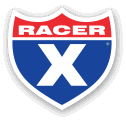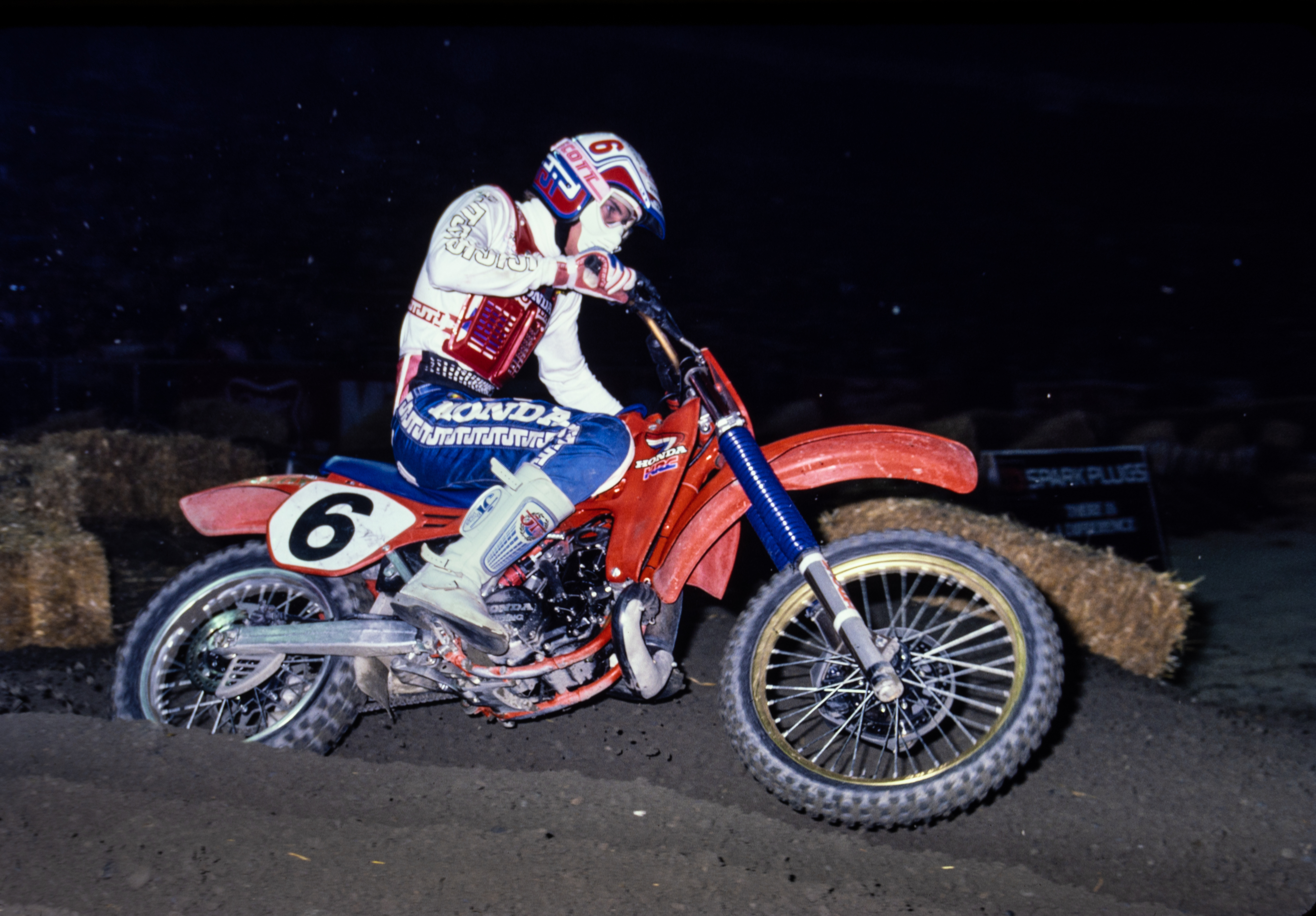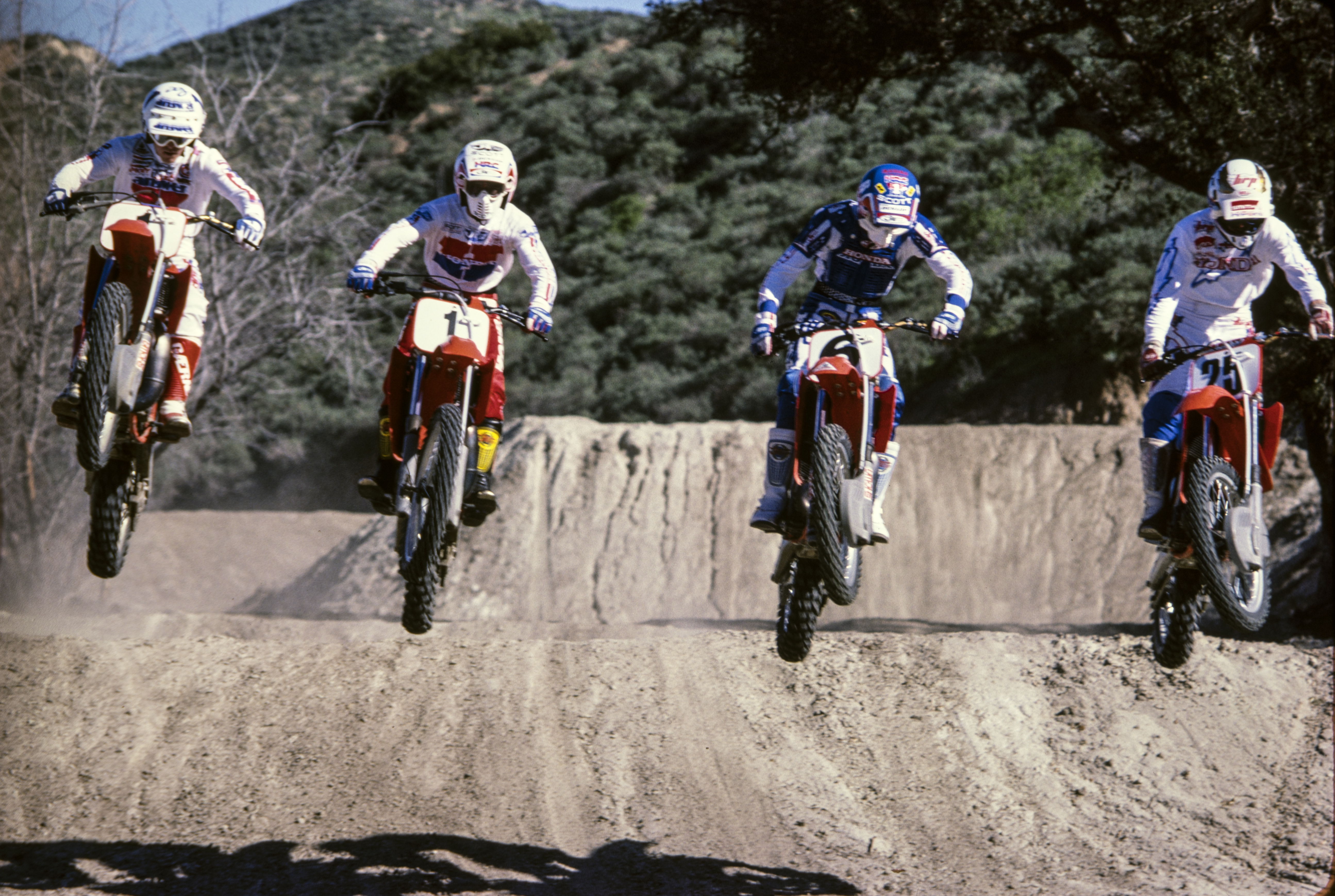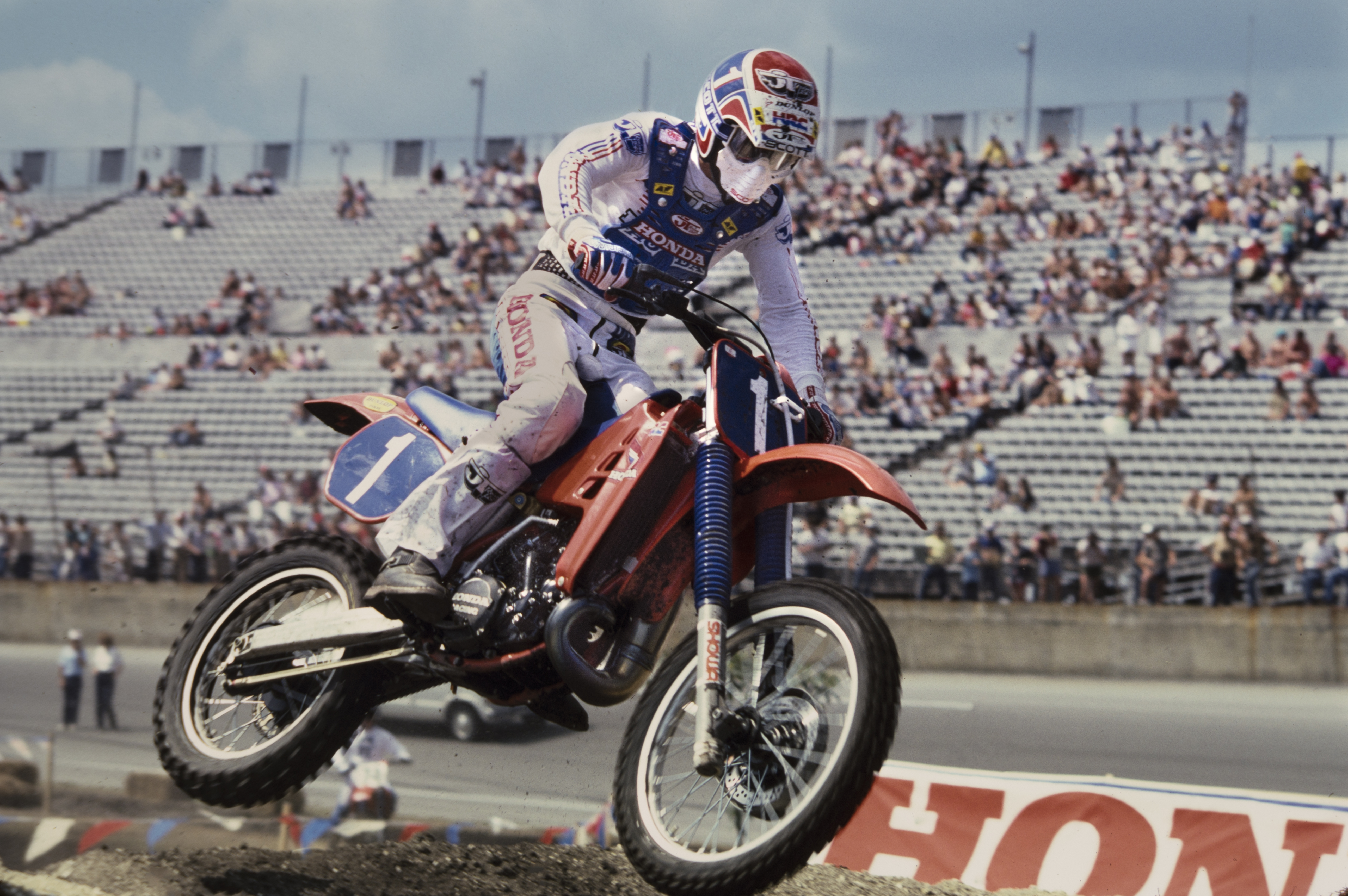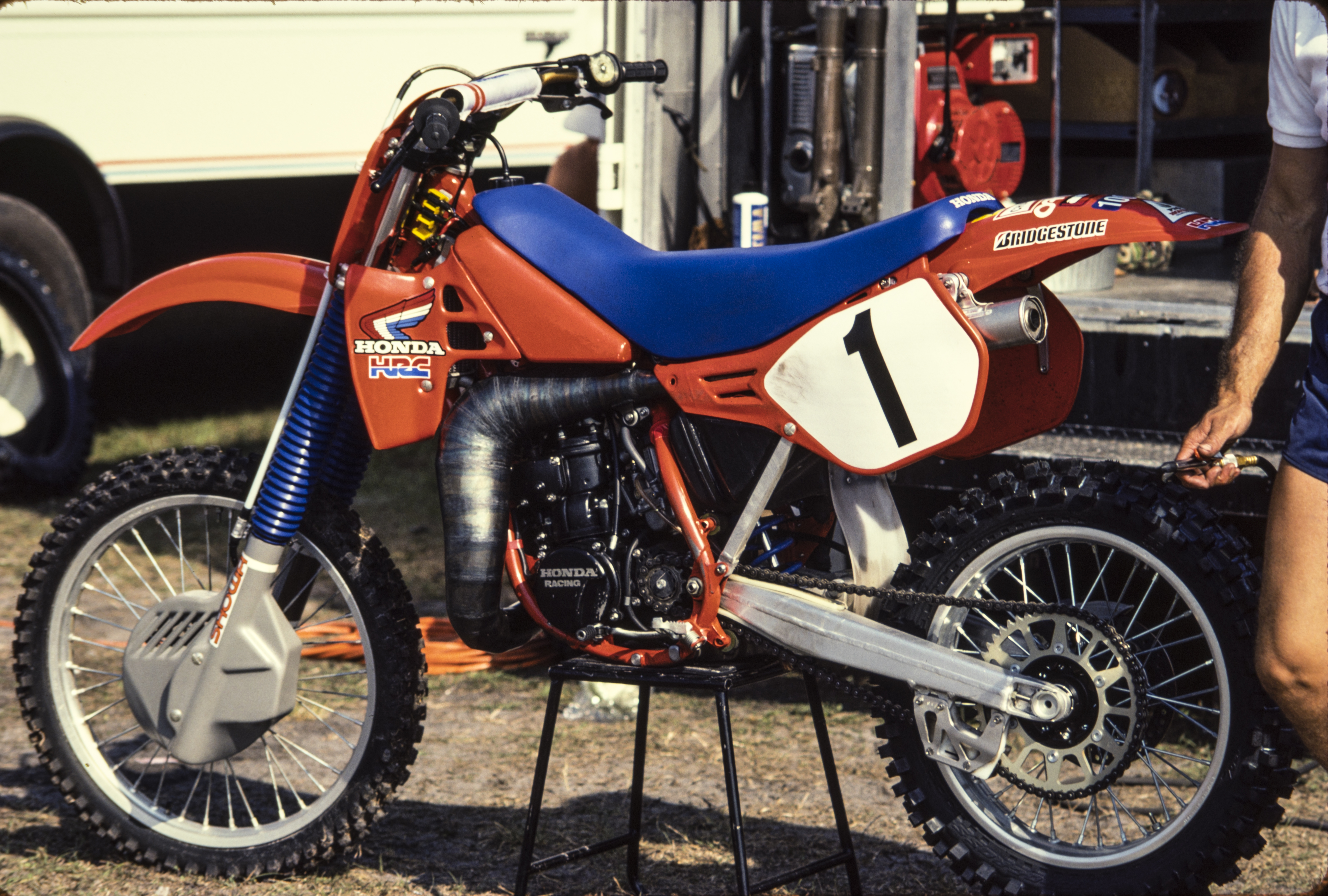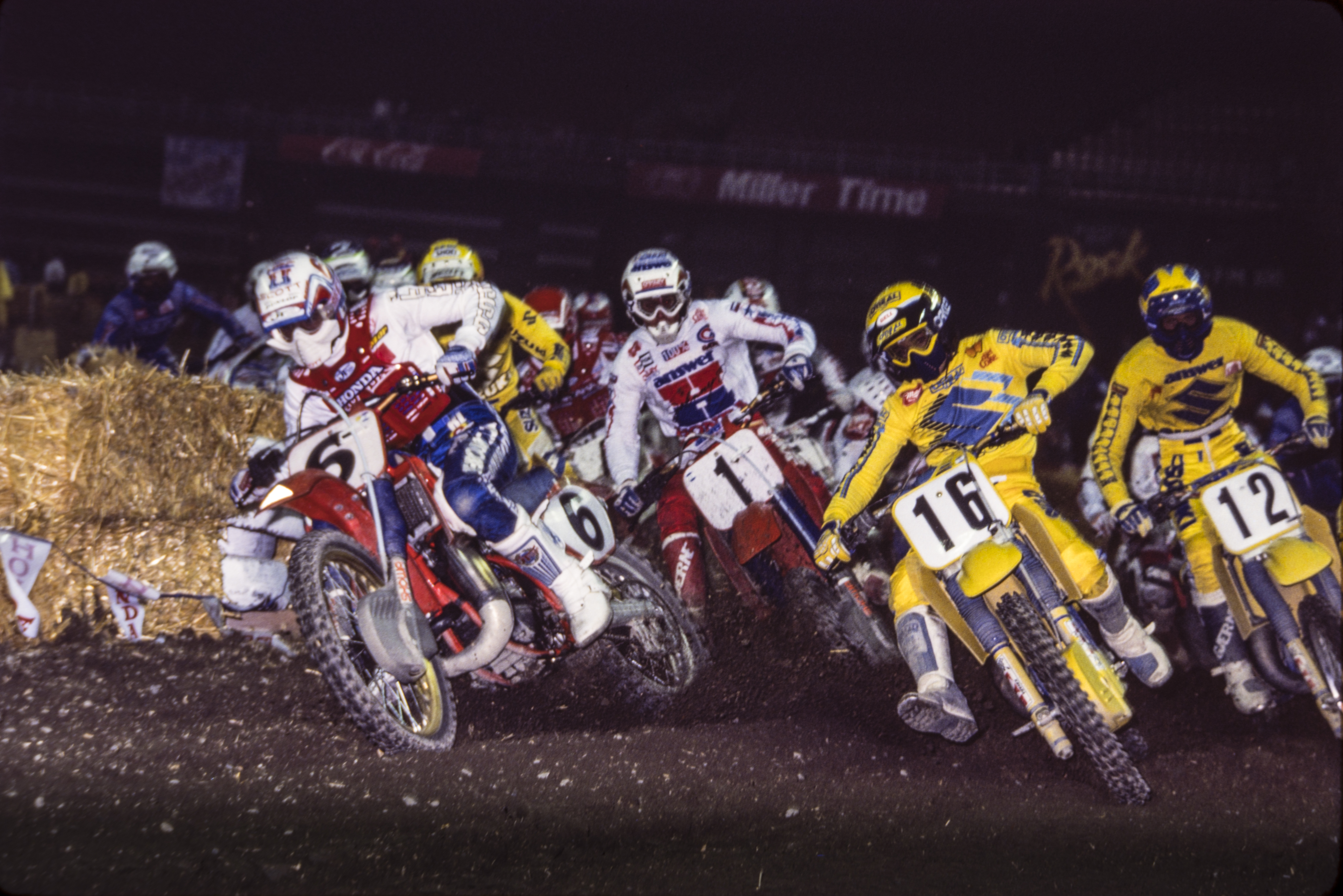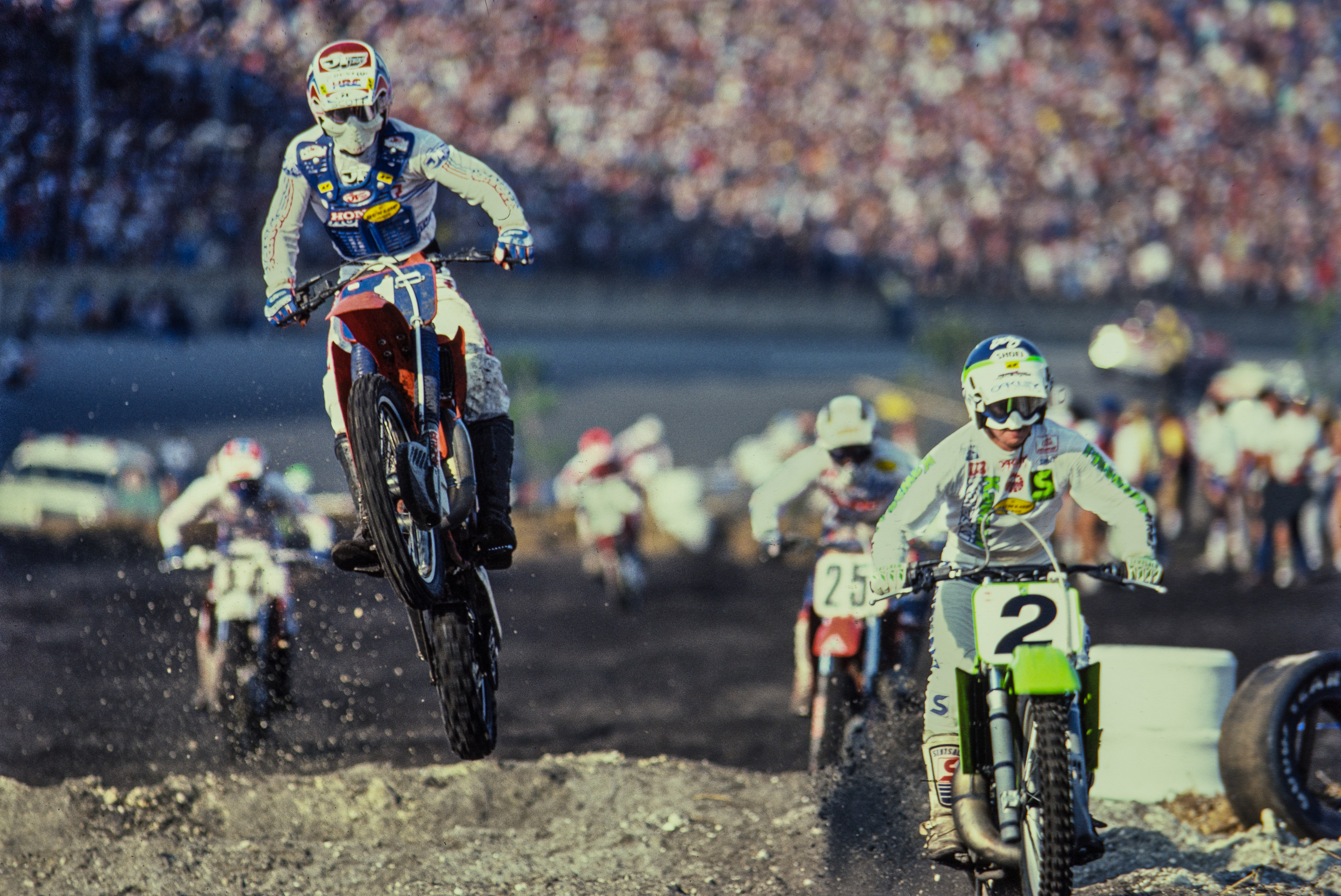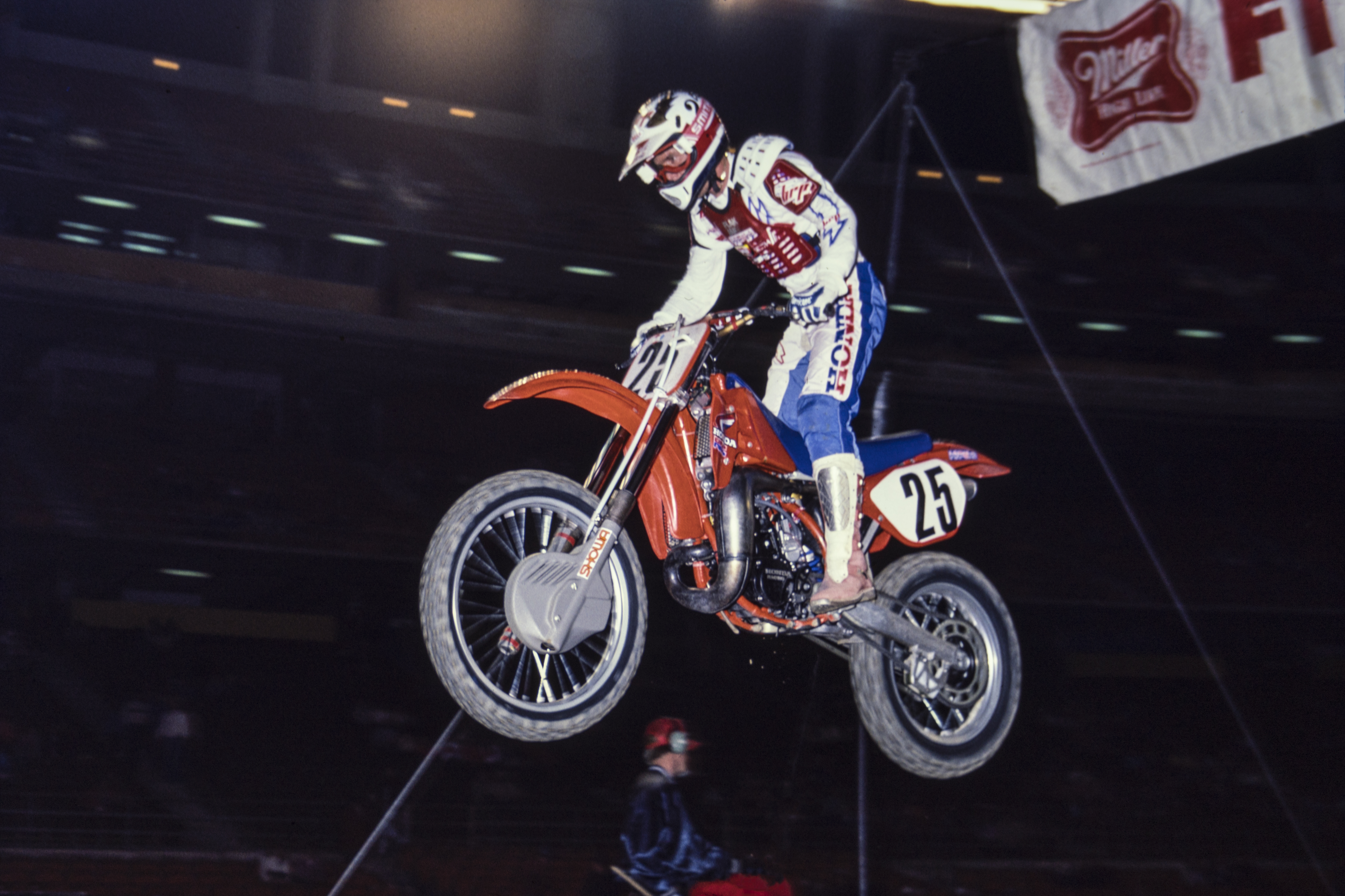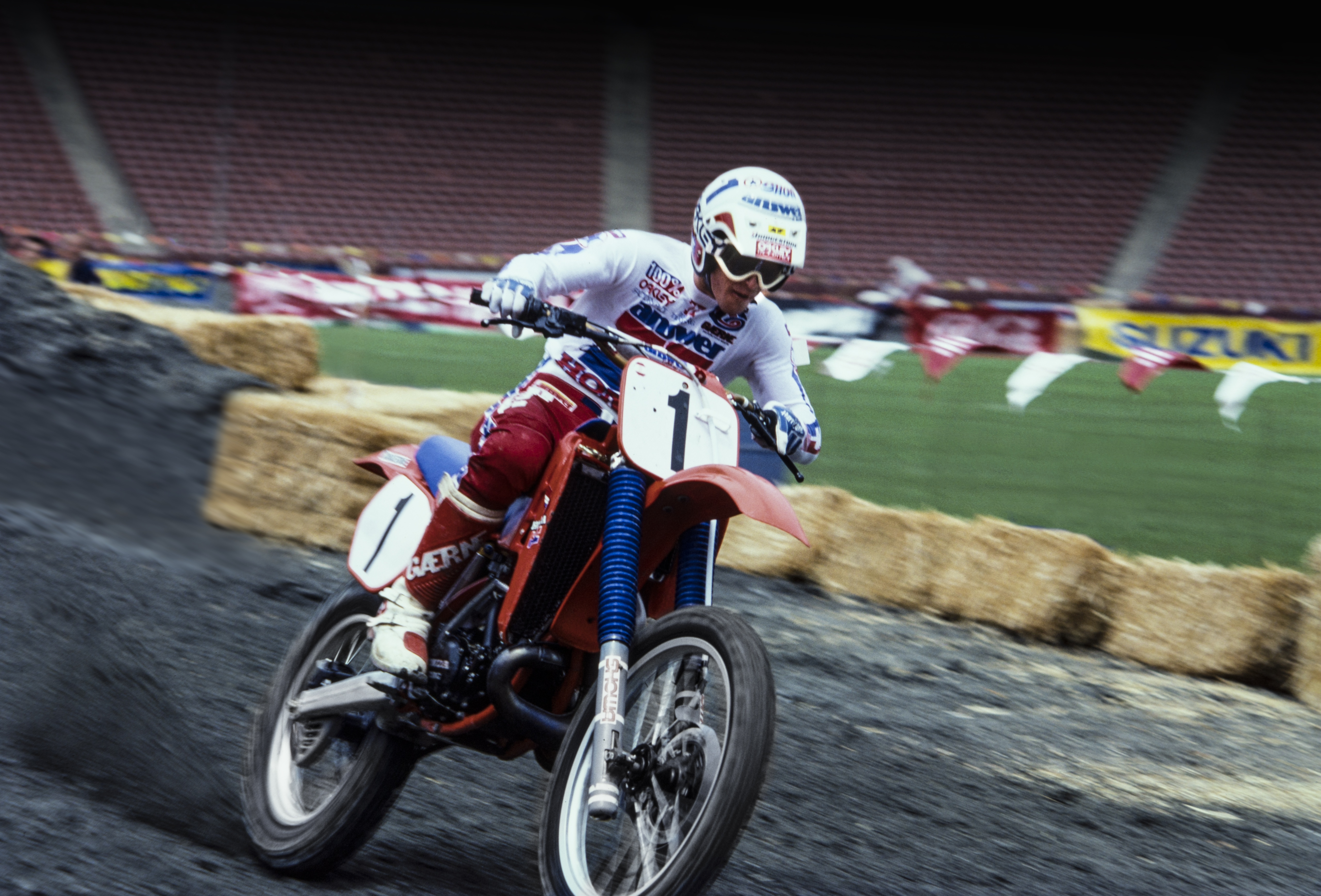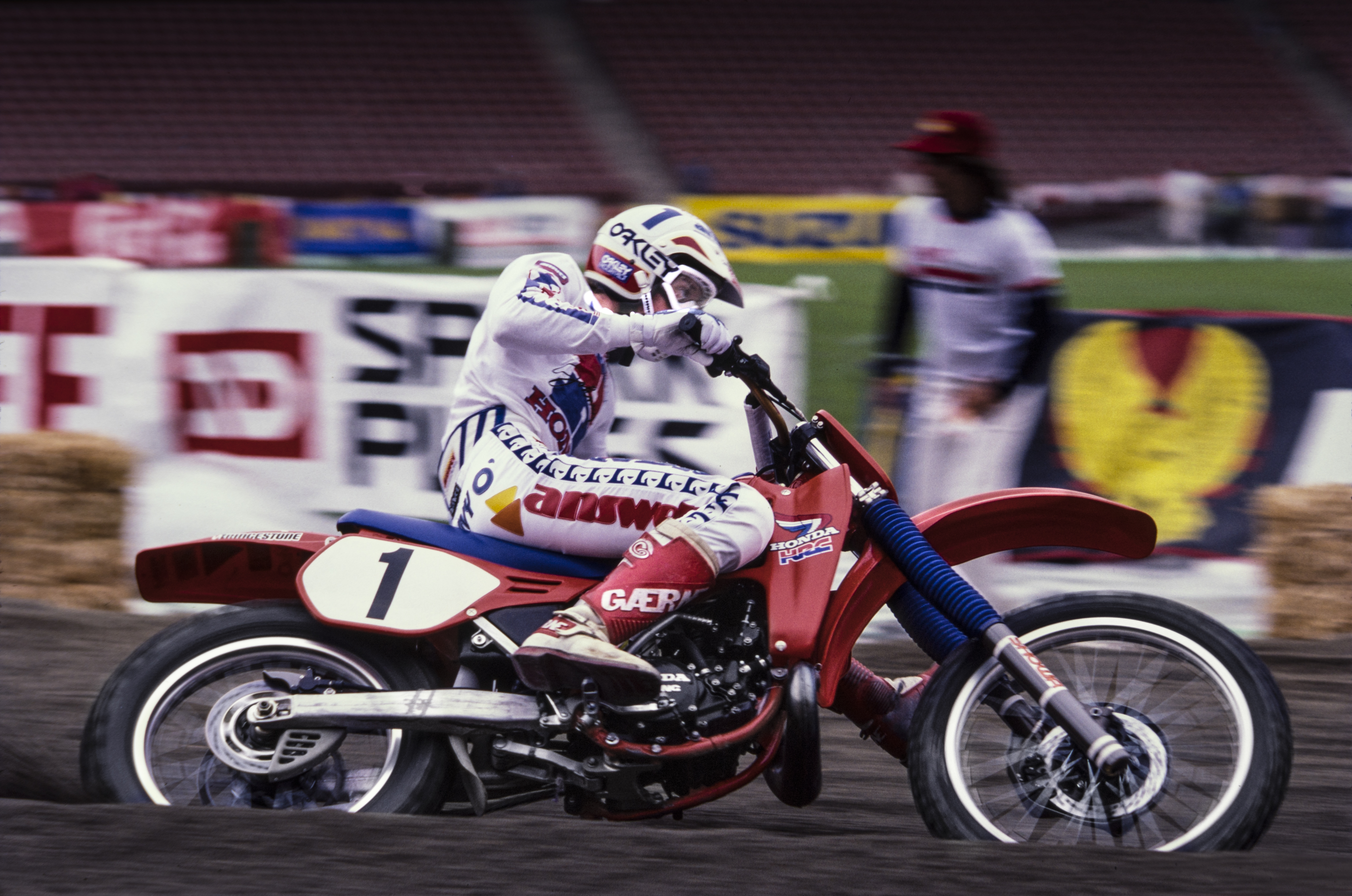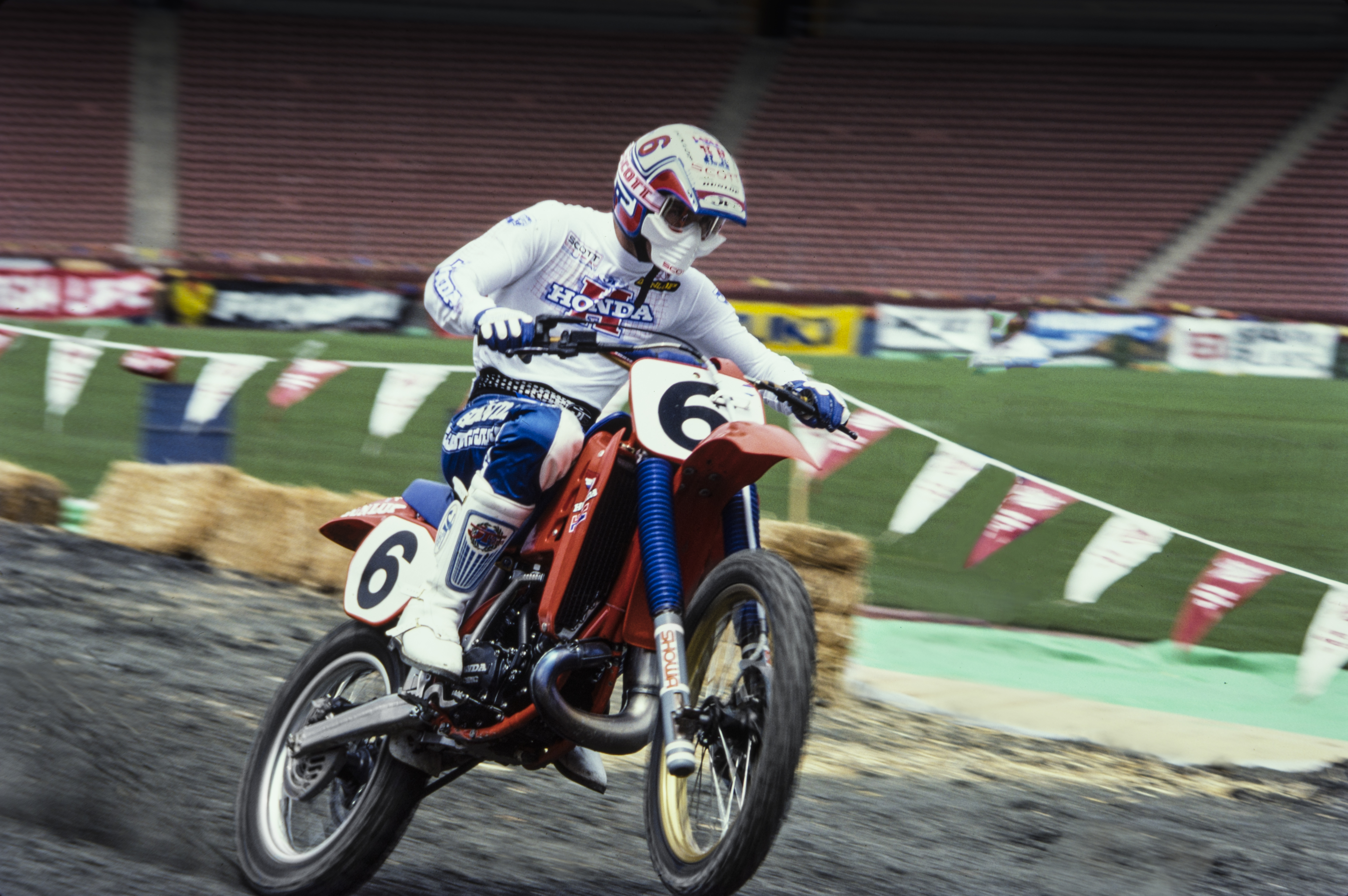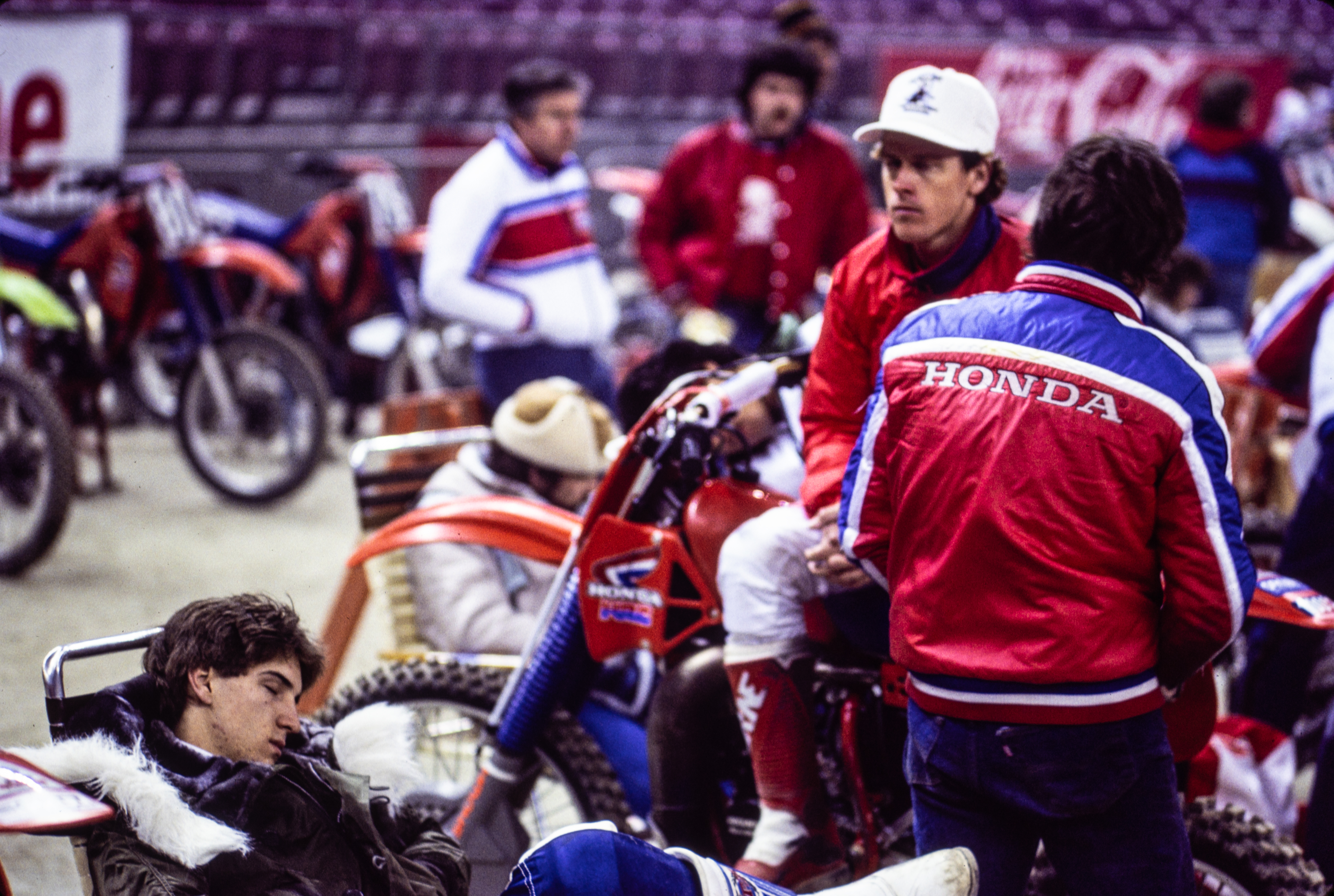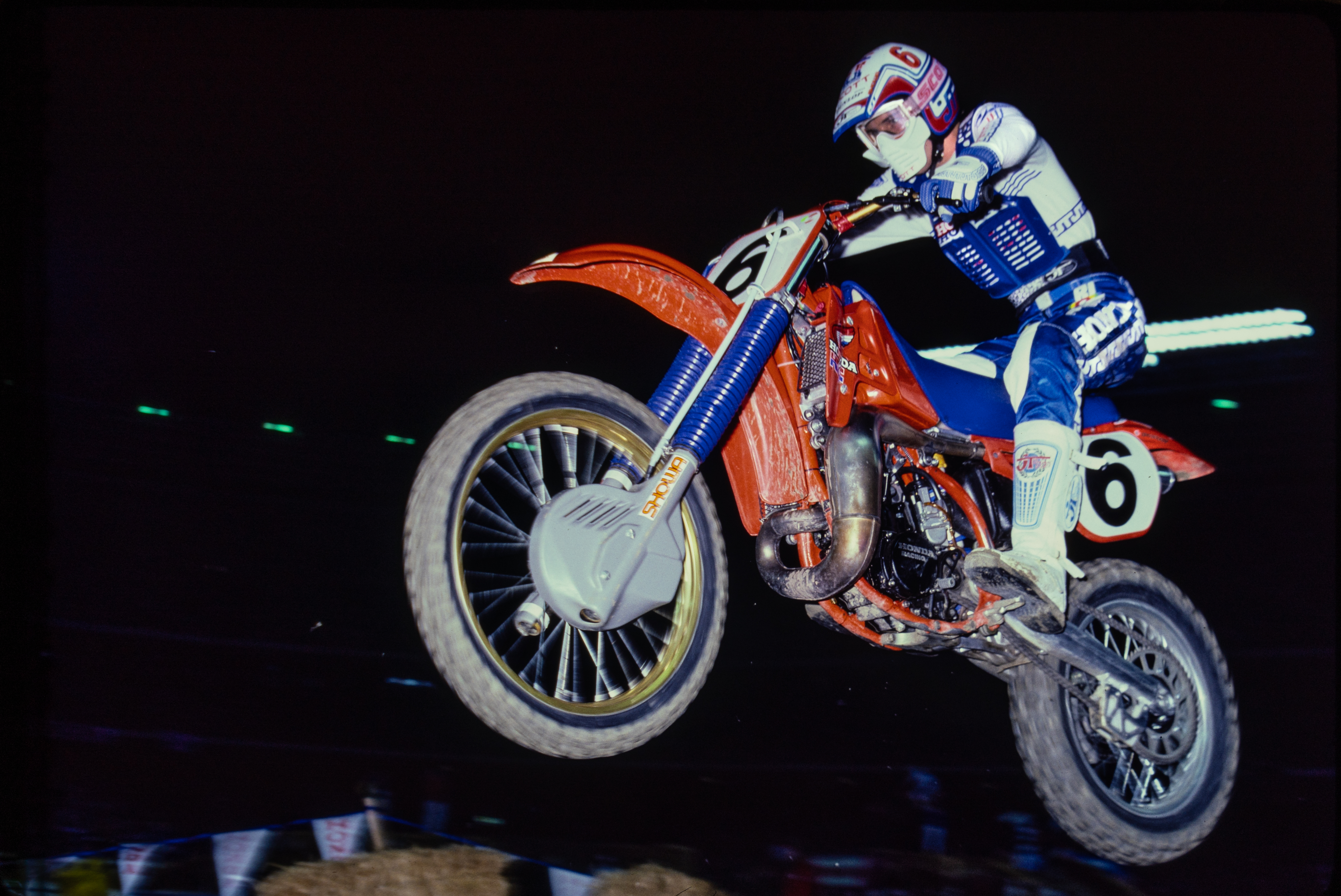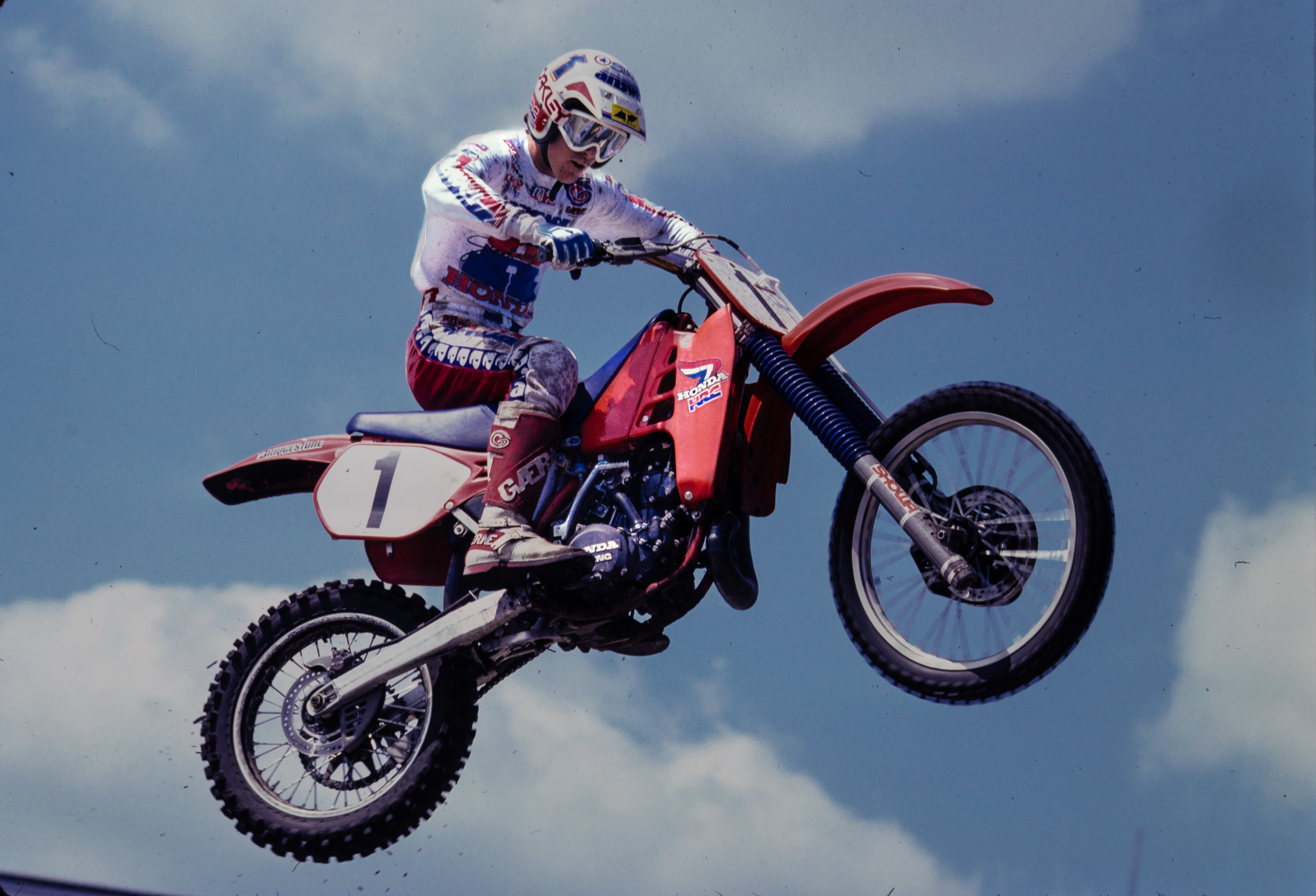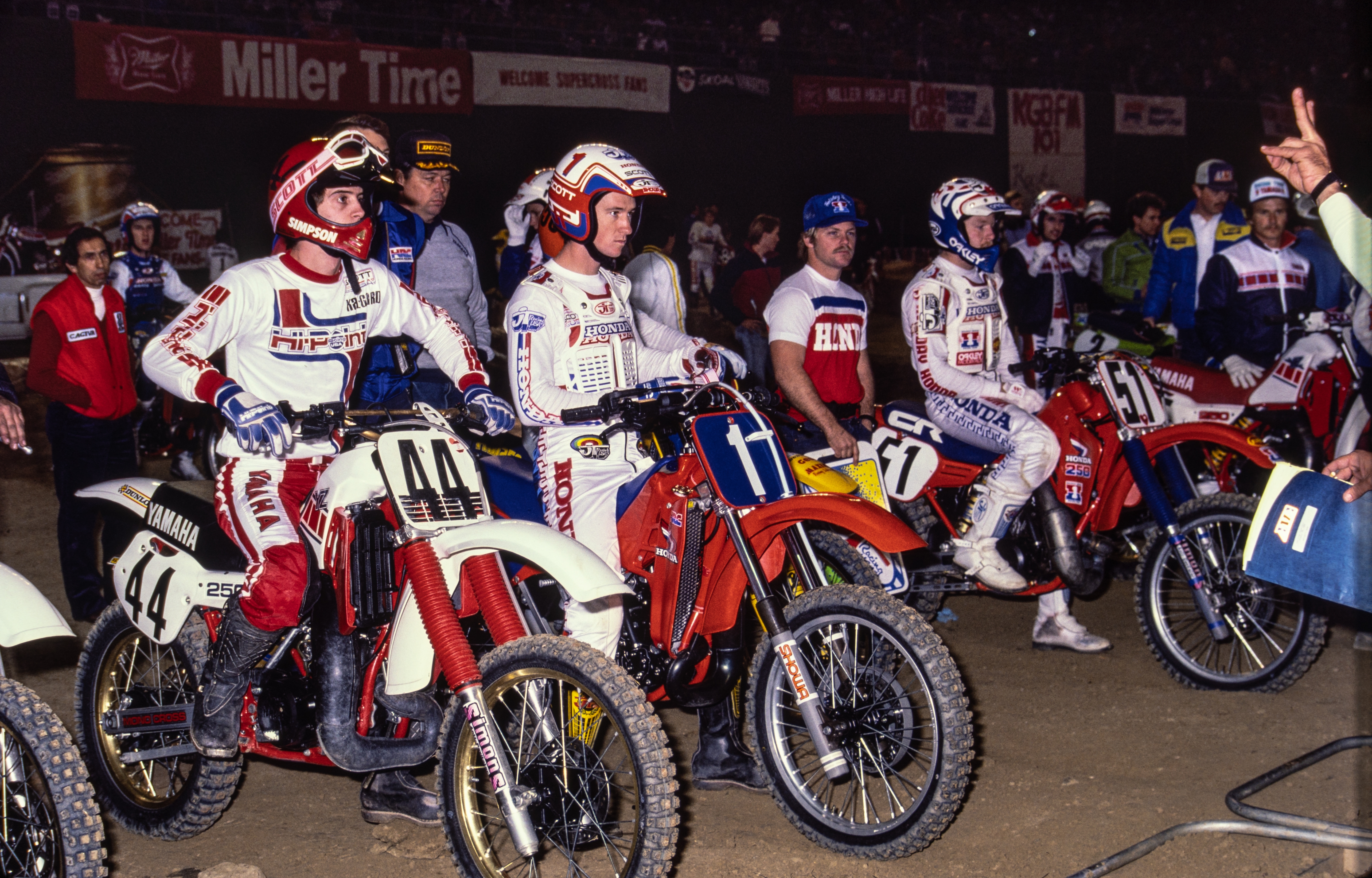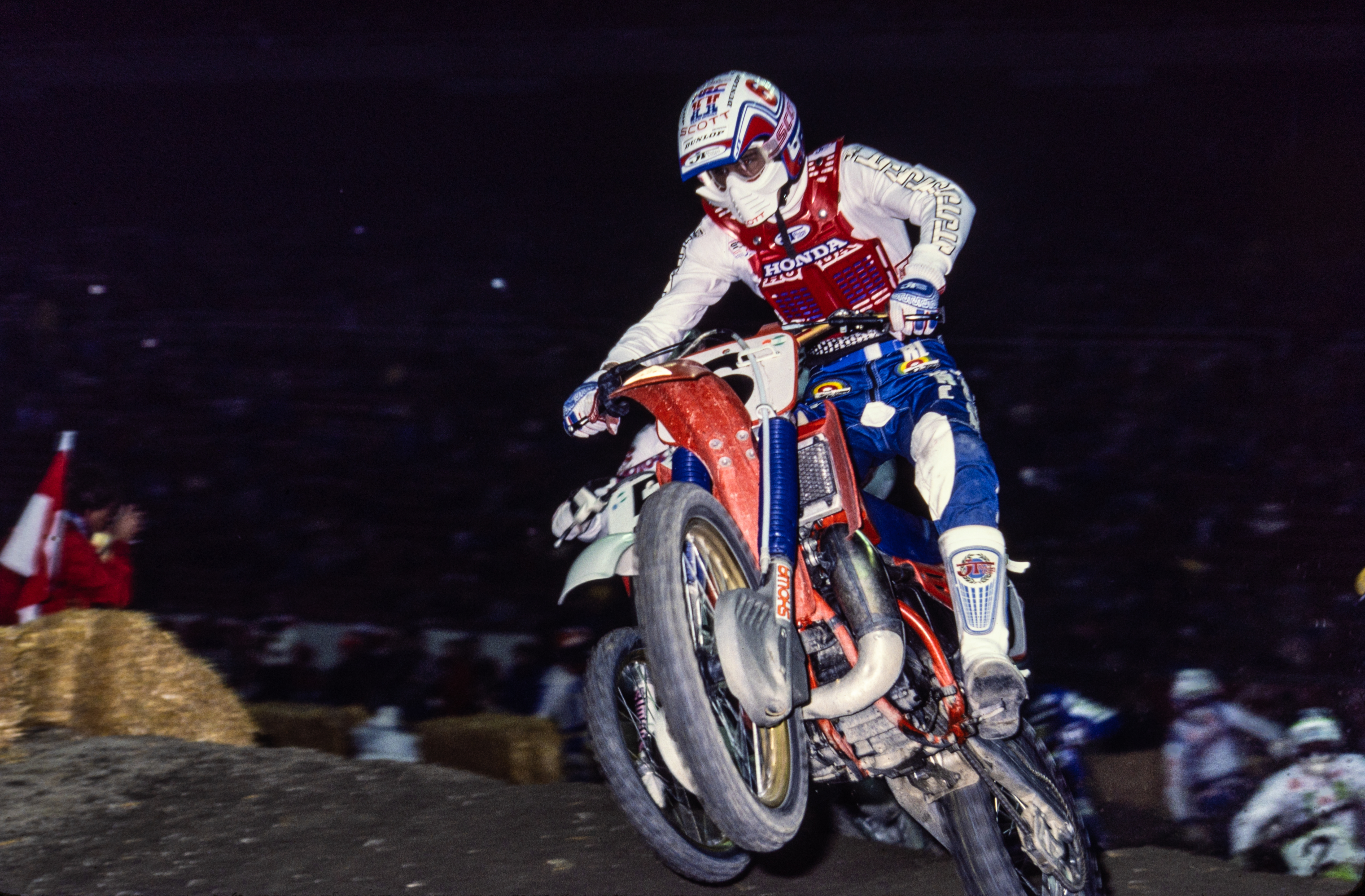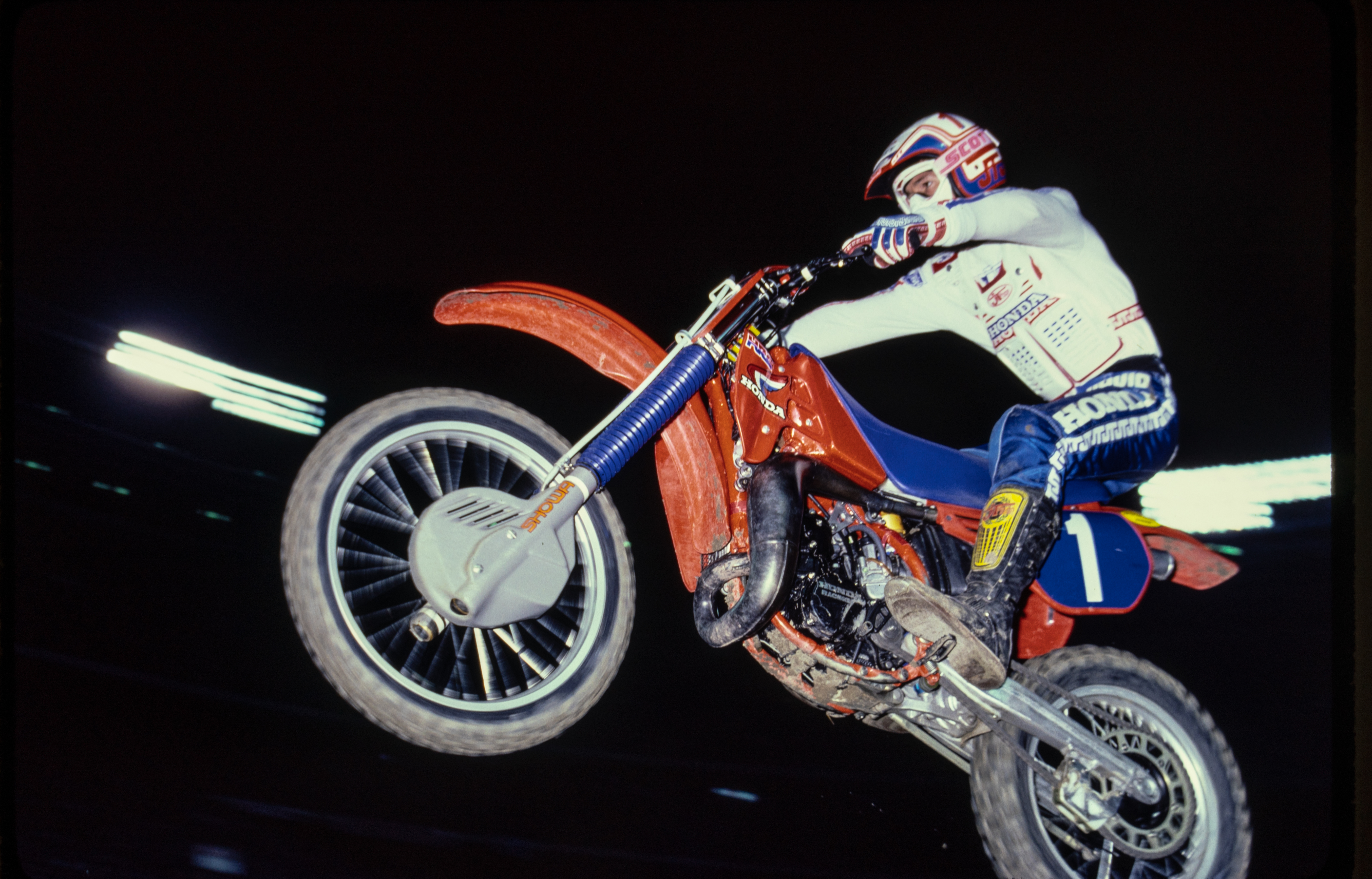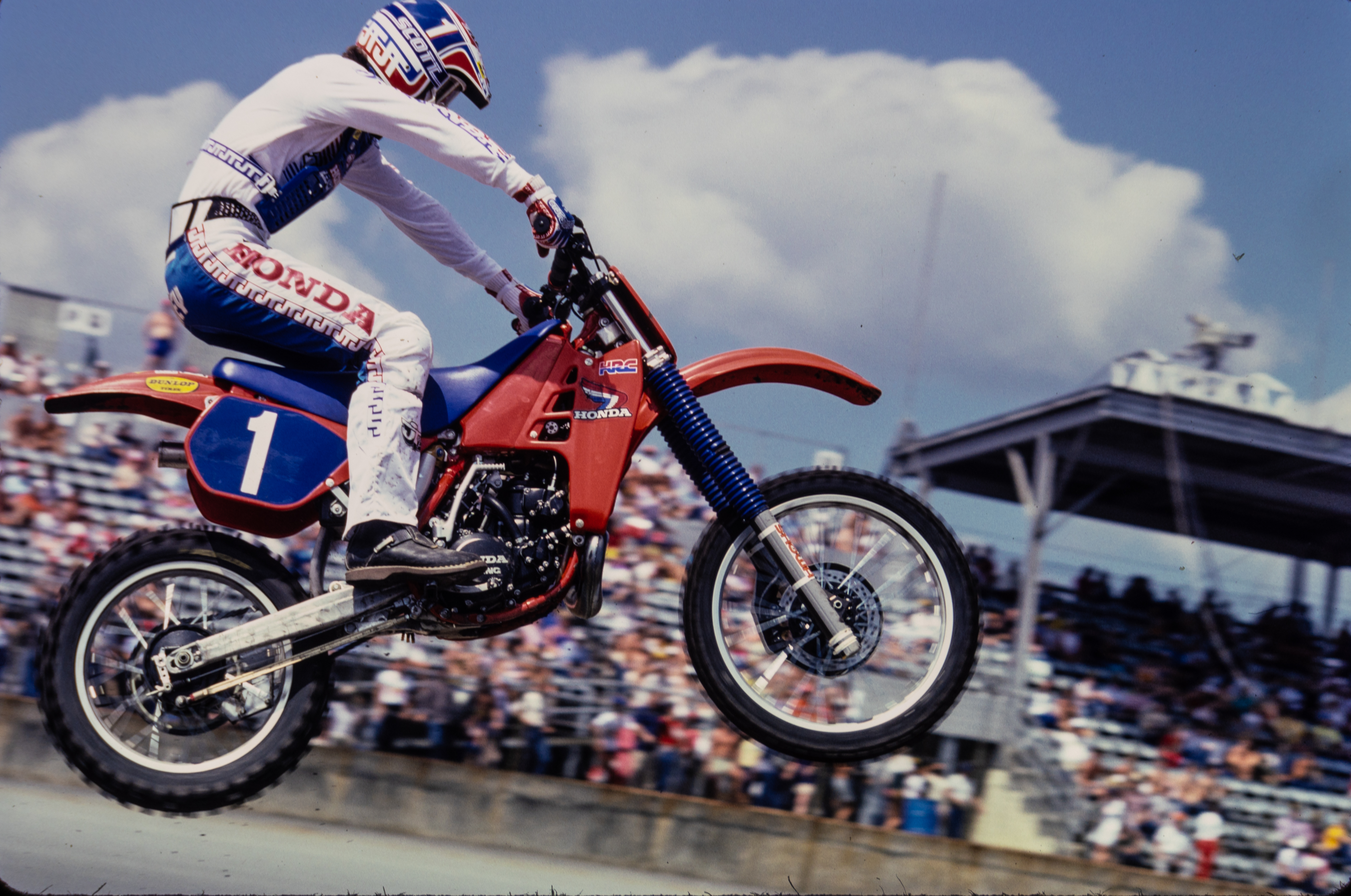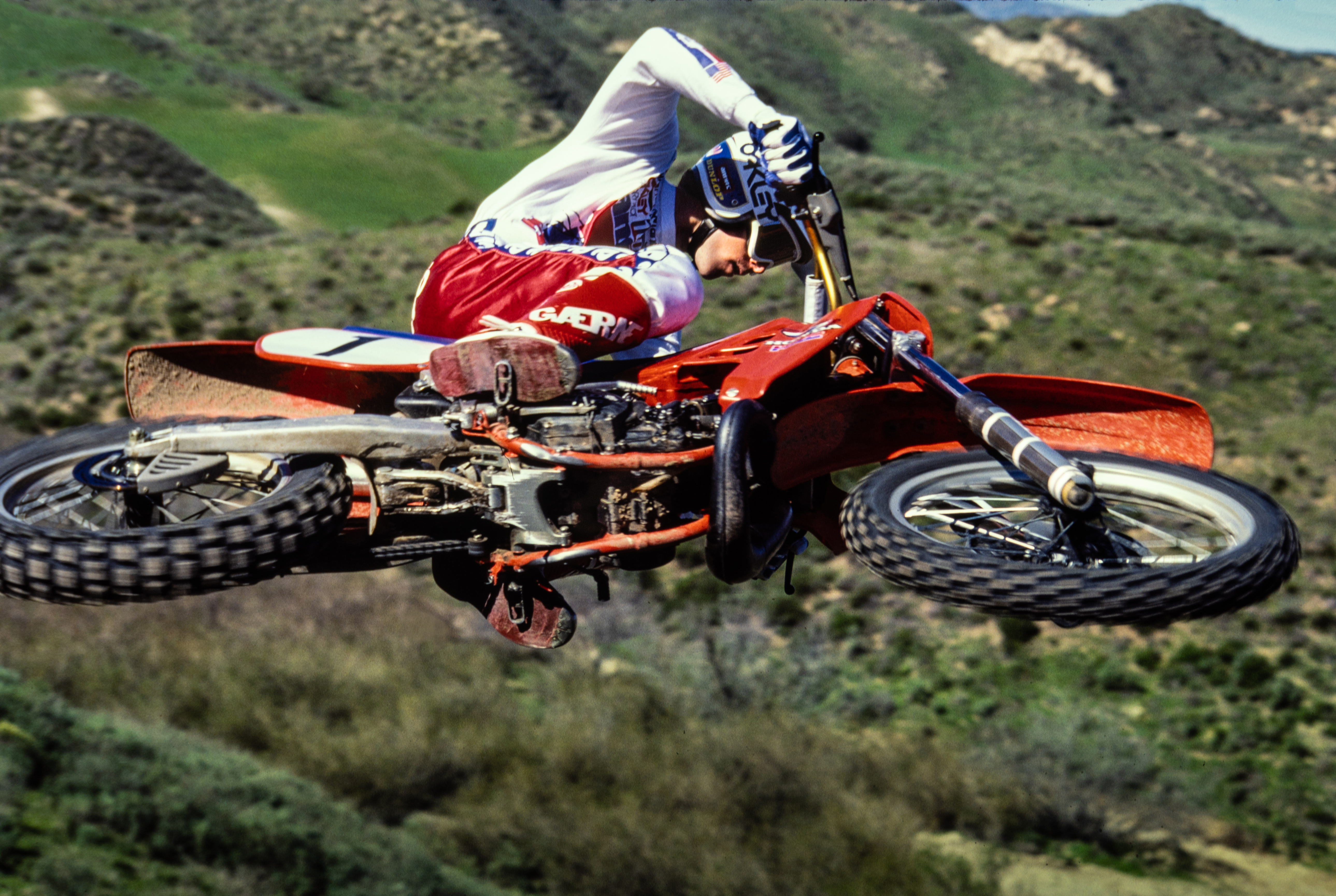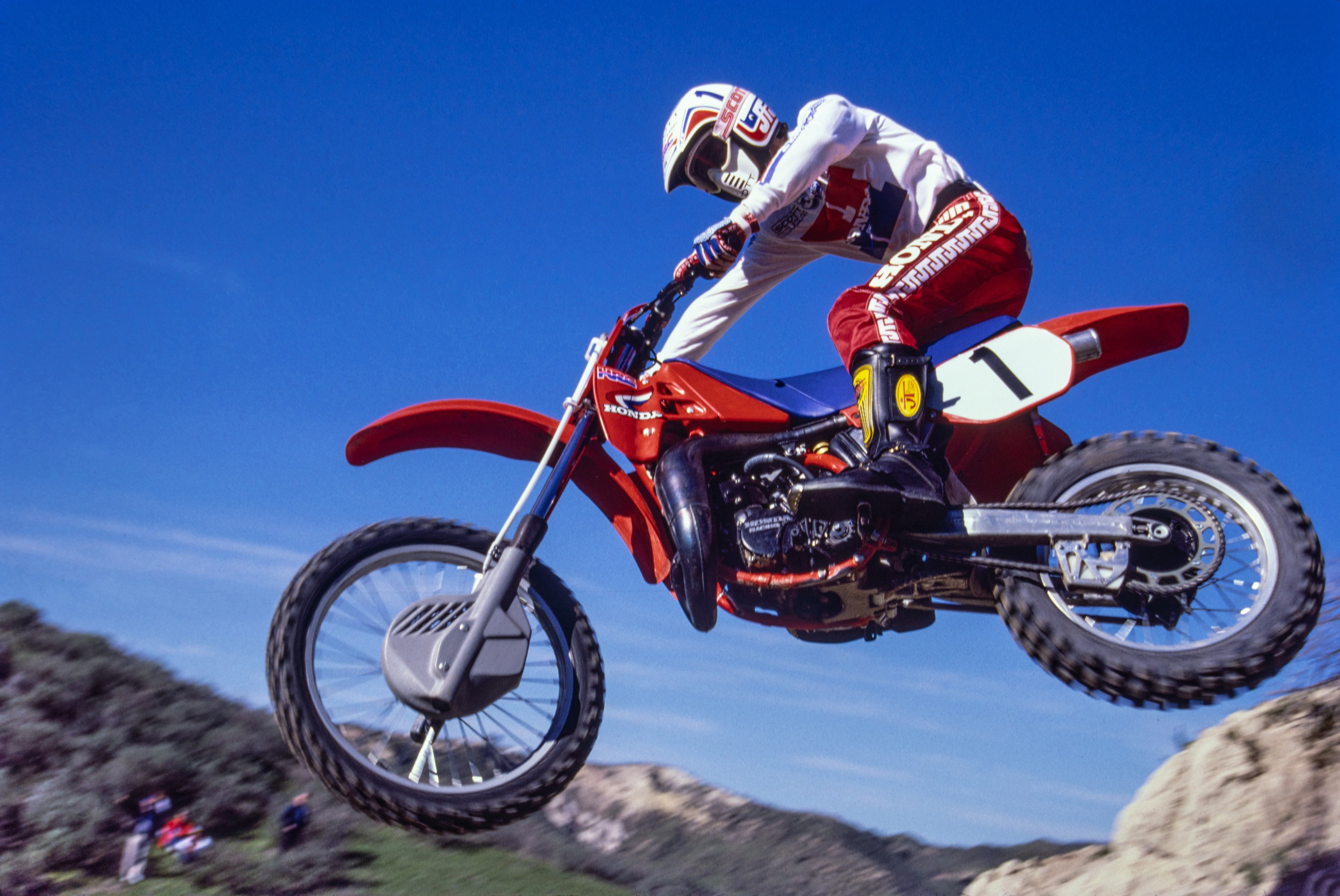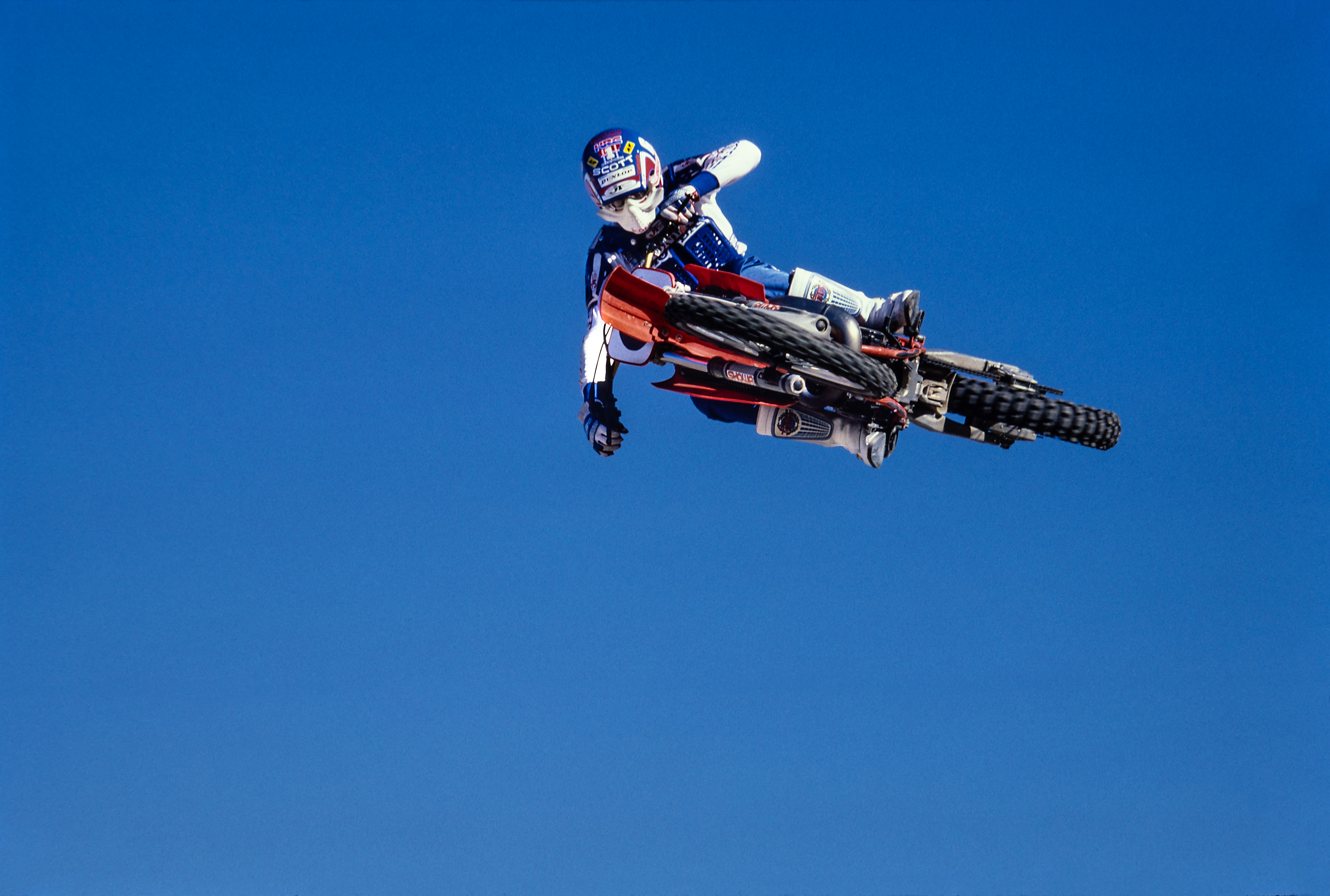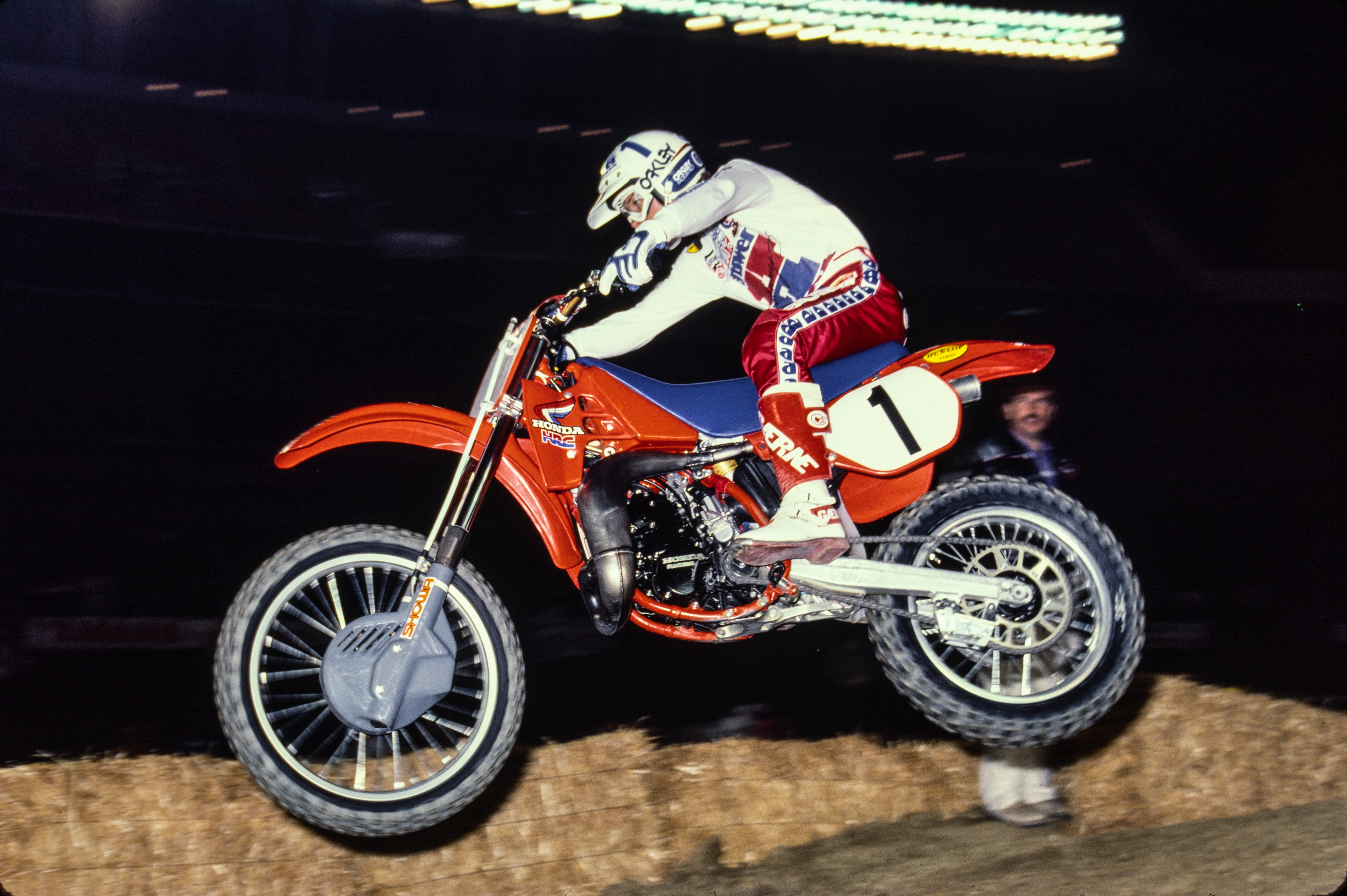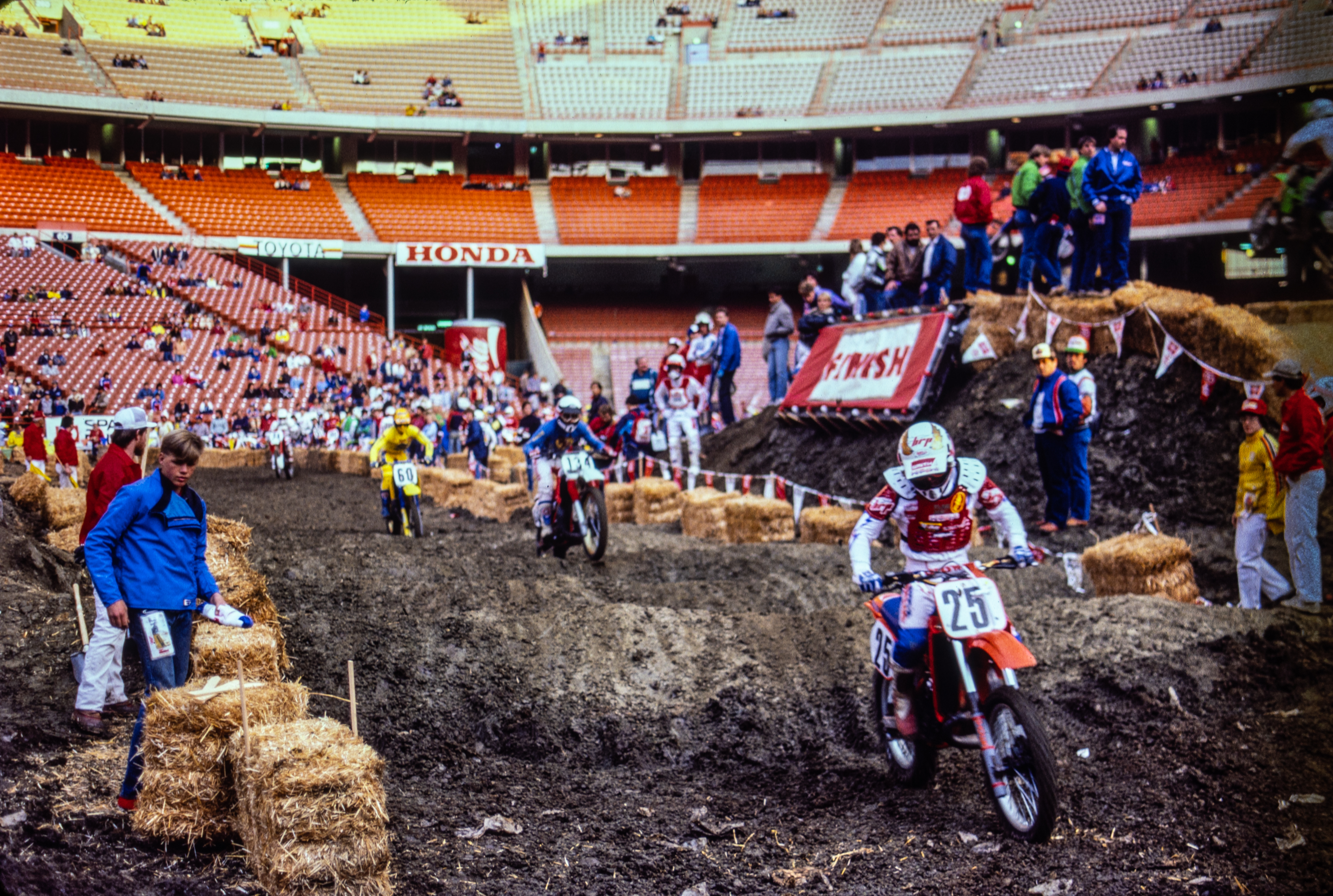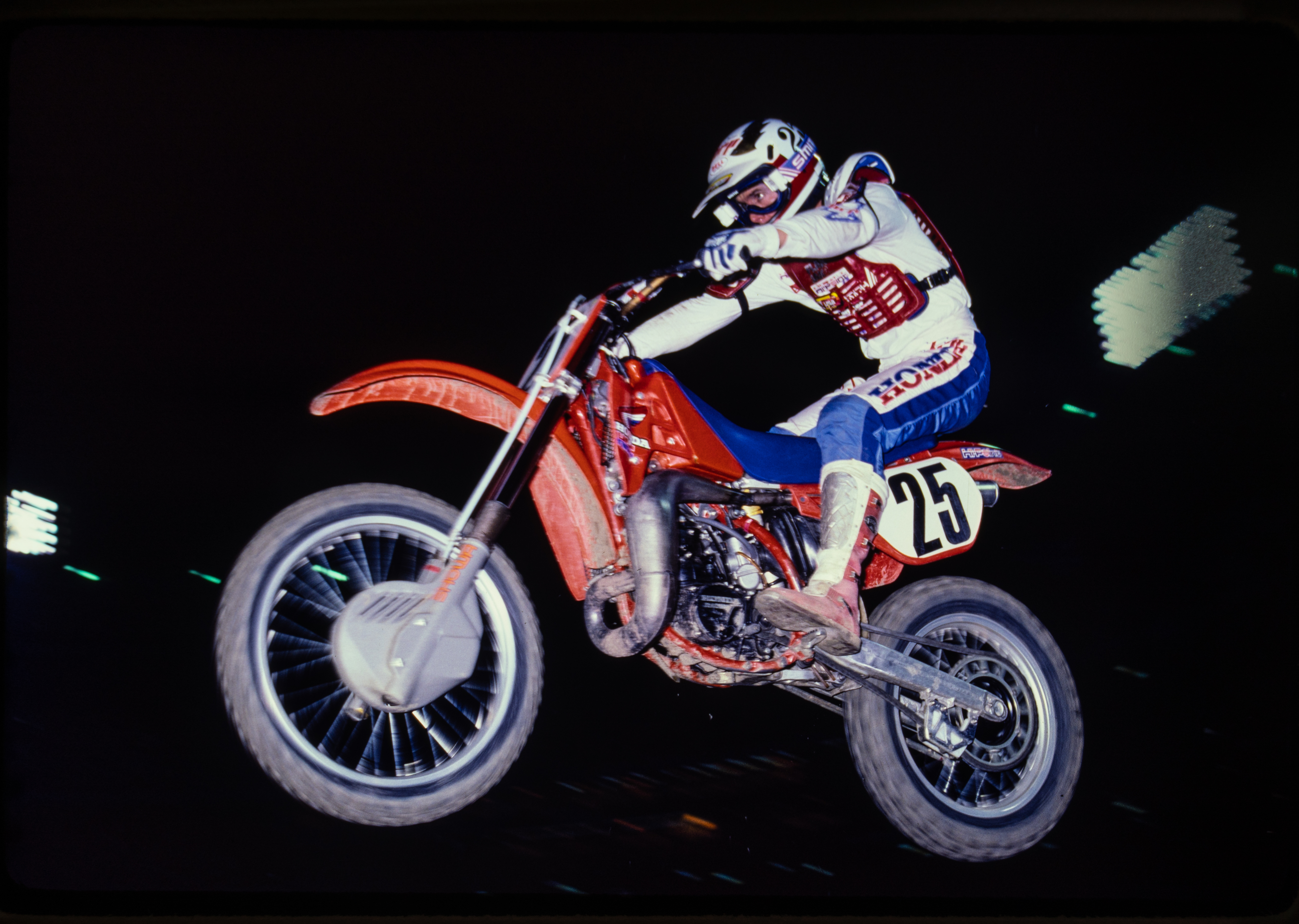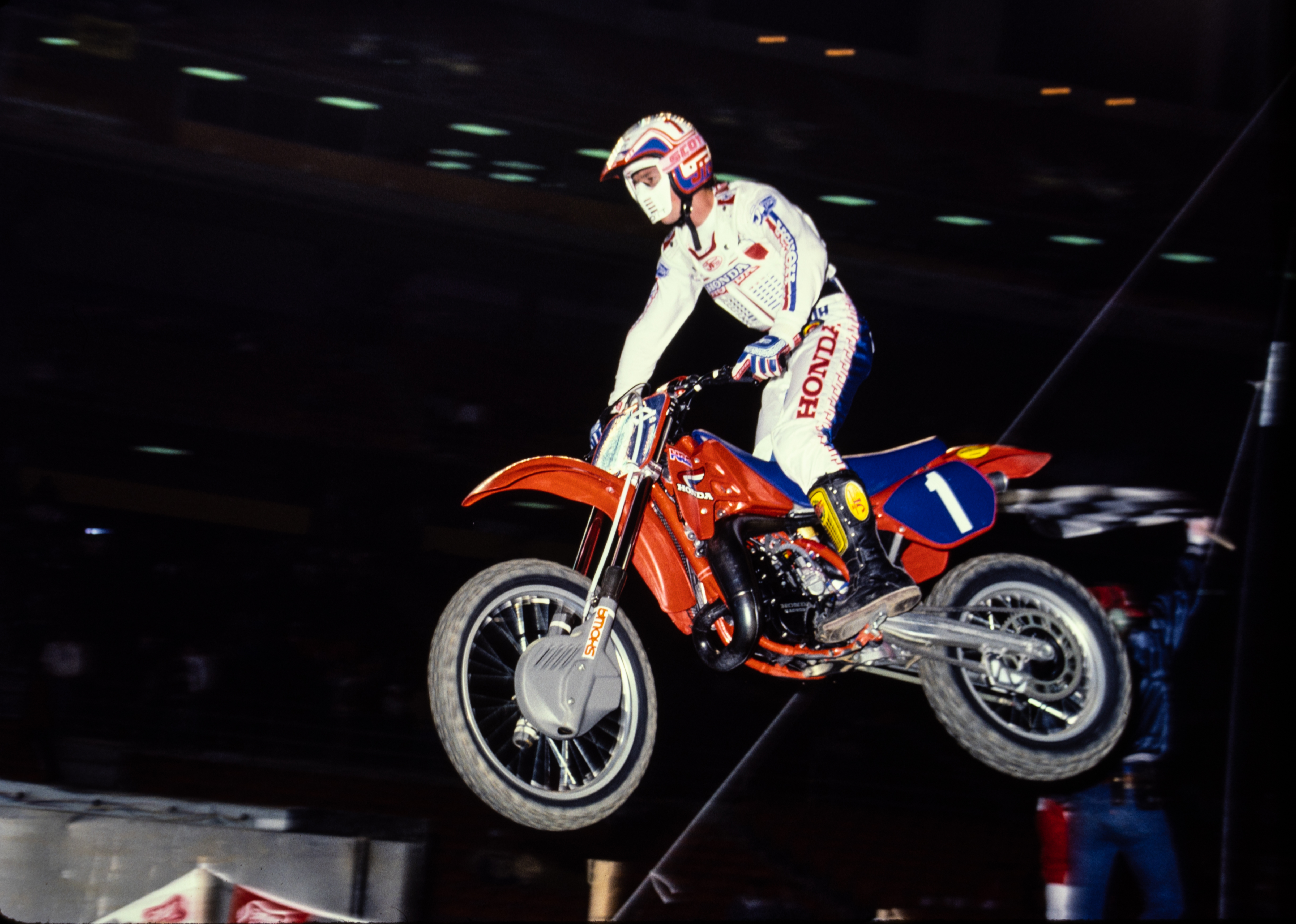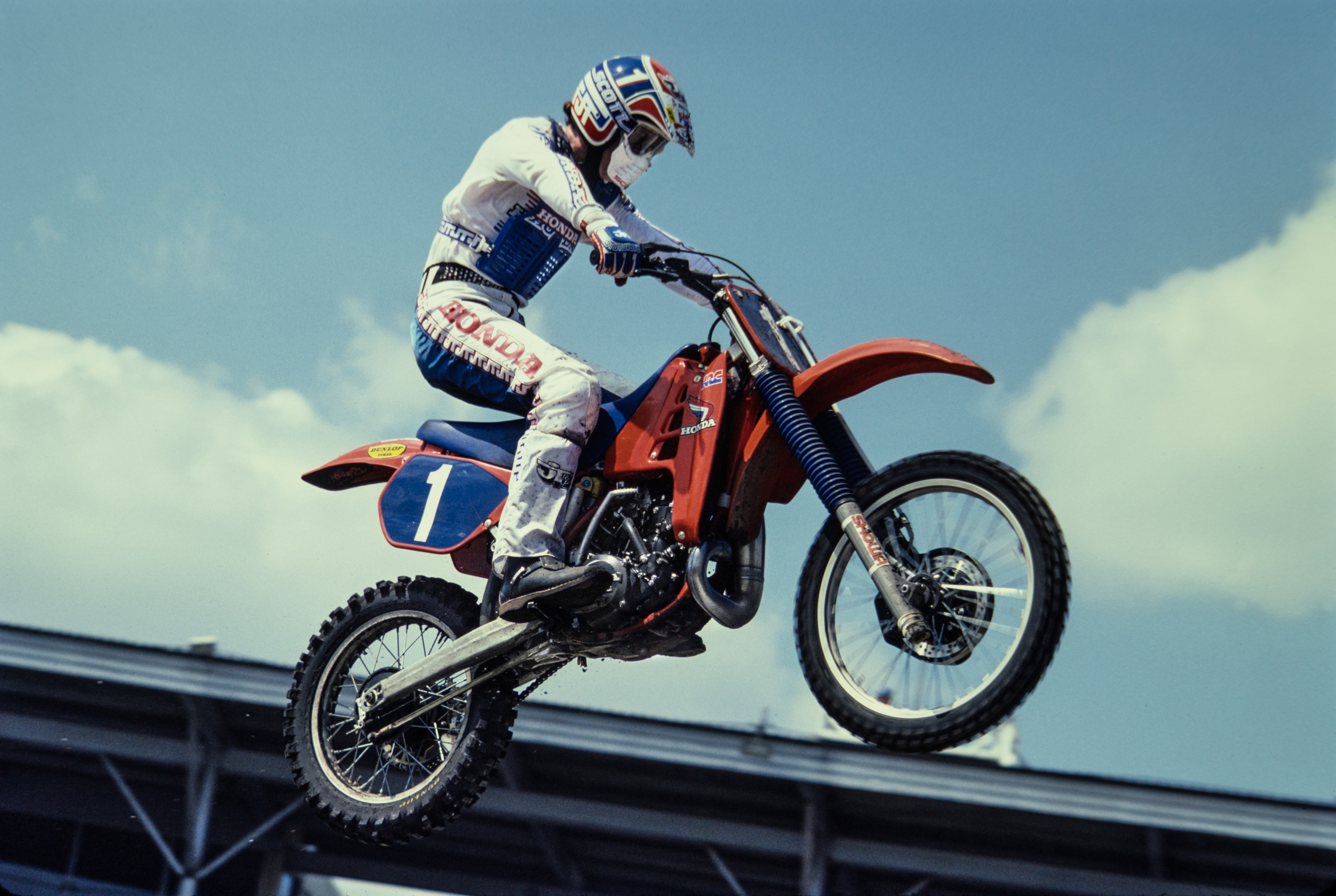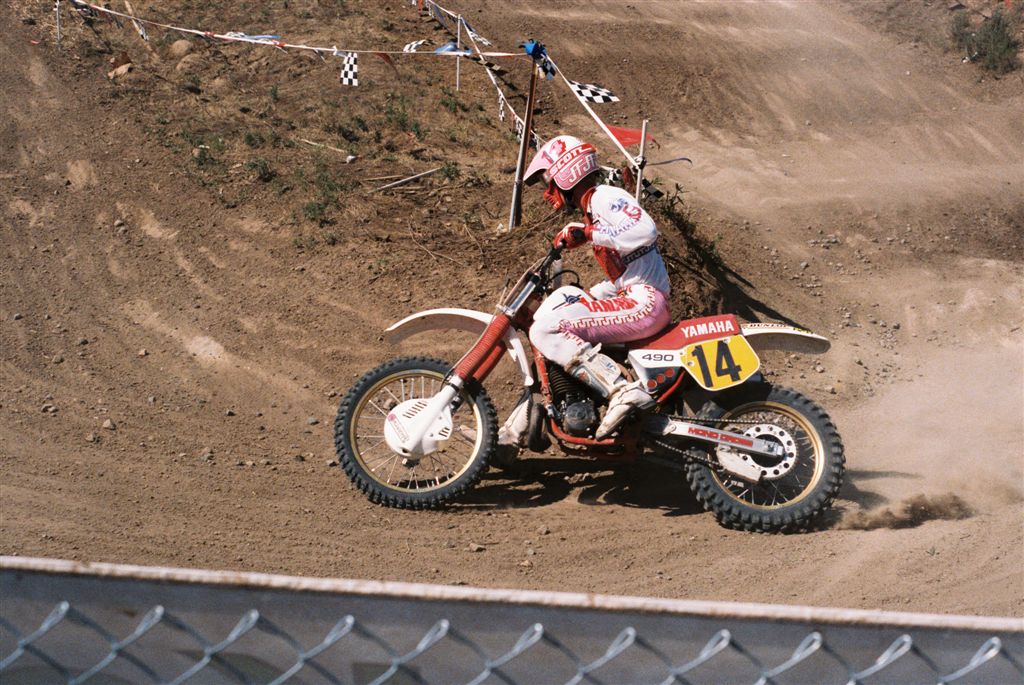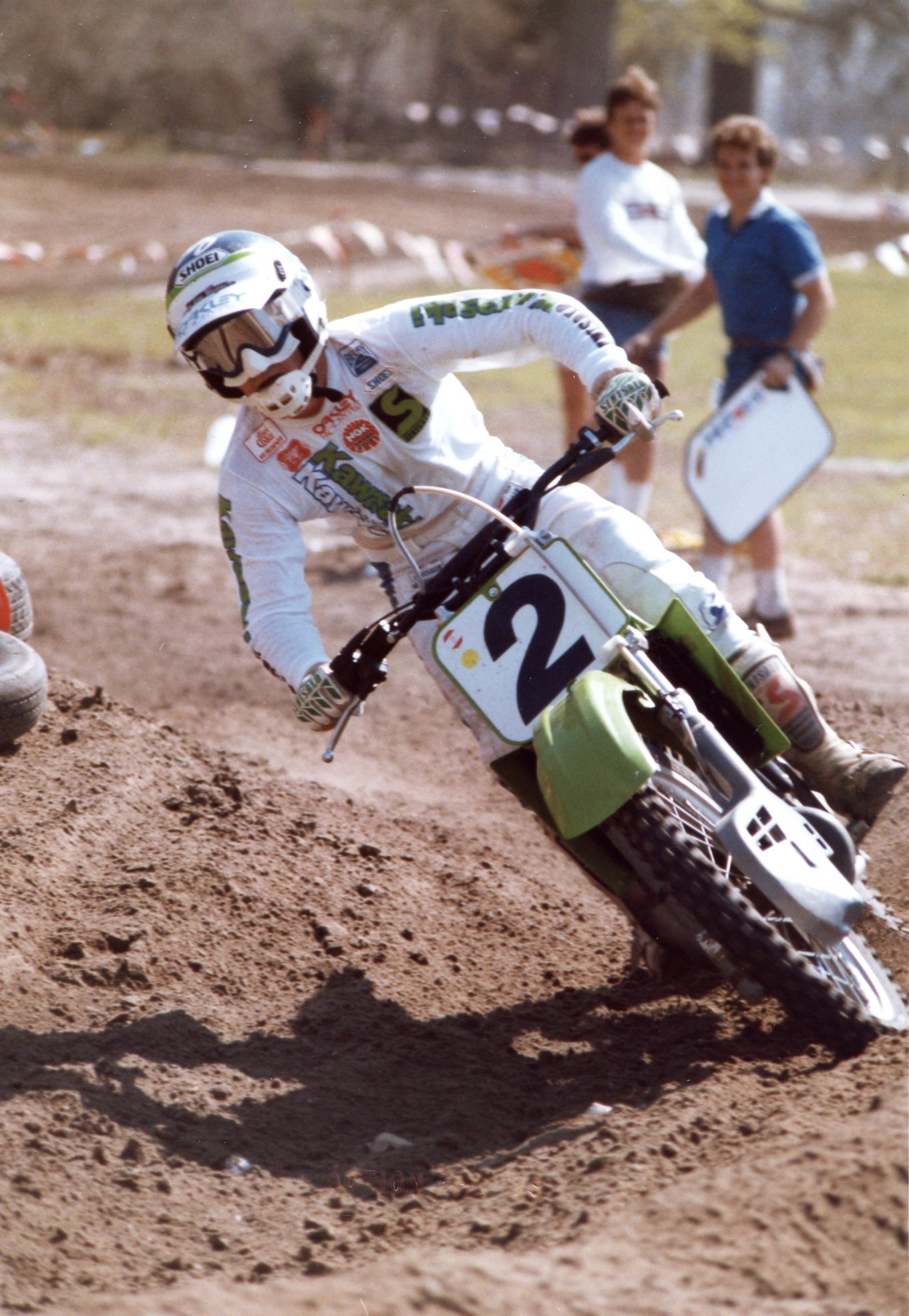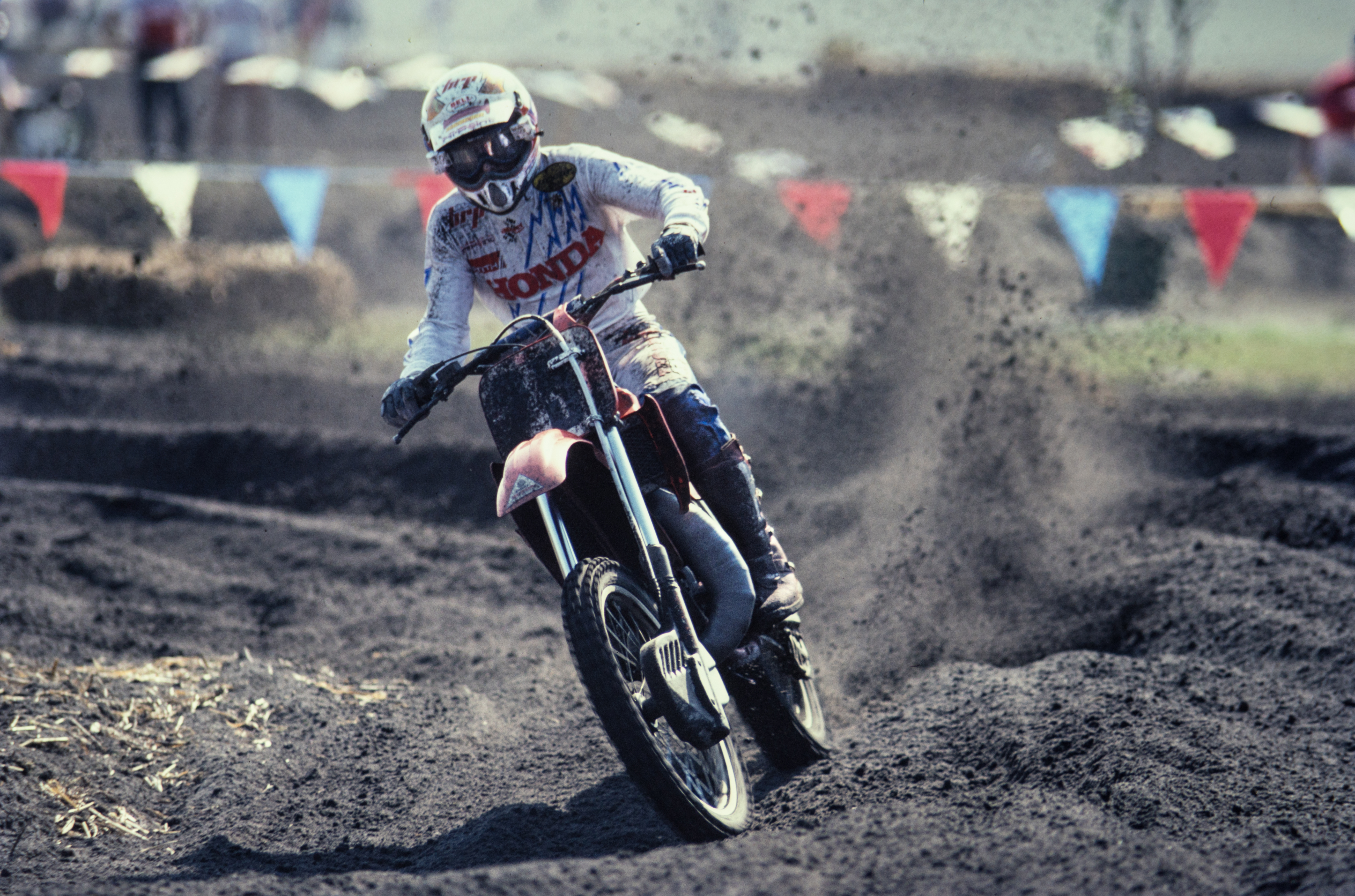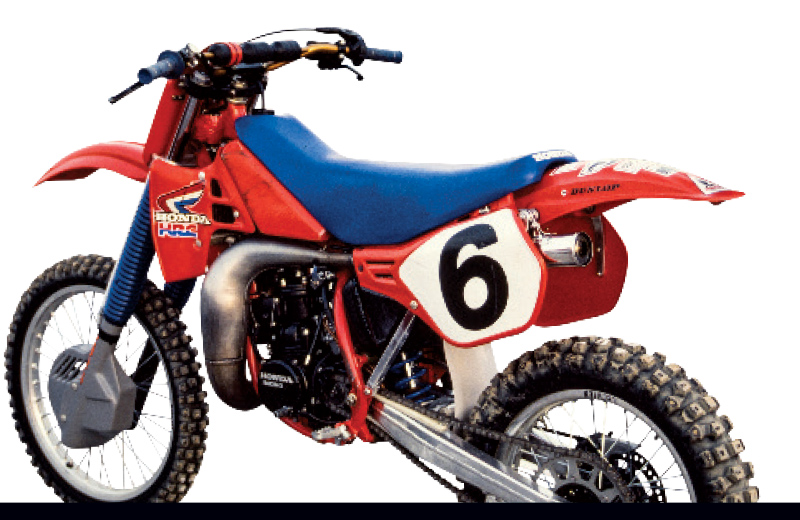
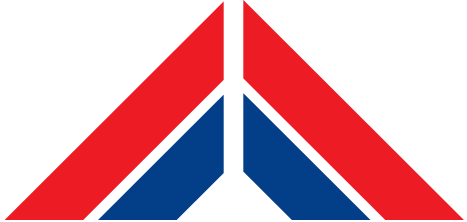
The People Involved

Yamaha

Honda

Honda

Honda

Kawasaki

Honda

Yamaha
The November 2019 edition of Racer X magazine featured a heavily edited version of this story. But you can’t run out of pages on the internet, so we’re thrilled to be able to bring you the full, uncut version here.
In 1984, the American Motorcyclist Association dictated that, beginning in 1986, all participants in AMA Pro Motocross and Supercross must compete aboard production-based motorcycles. The shock announcement—maybe the most radical in American motocross history—signaled the end of the works-bike era on the AMA circuit. However, the production rule left a brief window open for the Japanese OEMs to continue to develop their race bikes as much as possible before it went into effect. Some, like Team Honda, took full advantage of the grace period; others had already ceased developing works bikes. This led to an epic battle of the haves and the have-nots. We spoke about this period with some of the top contenders of that time: David Bailey, Broc Glover, Bob Hannah, Rick Johnson, Ron Lechien, Johnny O’Mara, and Jeff Ward.

Nineteen eighty-five—that was the year David Bailey had a kangaroo-skin-covered seat! I mean, what is the point of having a kangaroo-skin seat? What was the performance advantage? Was it Honda saying, “We have money and we have to spend it?” The 1985 title fight between me and David definitely turned into a David and Goliath story, only I was David and Team Honda was Goliath.
I could have probably ridden somebody’s bike at some time, but I never did. I didn’t ride a Honda just because I didn’t want to like it more than mine.Jeff Ward

Broc was really funny in his comments—and he had a lot of comments. He would have comments riding behind me in a race. For instance, he’d let off the throttle going into the first turn at Hangtown and say something to me, just some funny stuff. He would also comment on the starting line, saying something like the fact that the fill plug on my clutch case had more technology in it than what he had in his entire bike. Honda had such an edge. It was just medicine for himself, I guess, but it was funny to me to hear his hilarious commentary on what all Honda was doing for my bike as opposed to what Yamaha was doing for his. It motivated Broc to ride the hell out of the bike and to try to stay close to me to try and set up a David-versus-Goliath sort of thing against this juggernaut team.

I rode a basically stock YZ250D in 1977, so I had production-bike racing experience. It was a good bike, too. Yamaha made a good stock bike that year—that’s all. Some years they do and some years they don’t, but that ’77 bike worked really good, you know? I actually auctioned off the bike that I won both SX races on at Pontiac that year. Honda had torn that bike down earlier that year at Atlanta. They thought we were cheating! But we didn’t even have extra pistons for the bike. I told [Yamaha mechanic Keith] McCarty the day of the second night in Pontiac, “This bike ain’t even going to make the race because the piston is rattling so bad.”

I was just a kid winning in the Indian Dunes area, which was up north just a little bit above L.A., and I happened to be affiliated with Al Baker, and that got me a Mugen Honda ride, which put me on the map. That was a Honda family deal anyway. And it was a one-time only deal. Hiro Honda wanted to make one effort at it, and I got the role and won races and everyone just knew who I was, and then instantly I went to the Honda team. It really lined up for me from ’81 through ’86. Just think about all the firepower that had—and definitely with those works HRC Honda bikes, which were like unbelievable pieces of mechanical art.

I had won the ’84 125cc National Championship, and I was sitting pretty good. My contract was up, and I was definitely happy with Kawasaki and where the bikes were going. I had a lot invested there and a lot invested in the people, so that’s what I did—I went in to Honda to just listen. Roger [De Coster] and the Japanese were there. Somebody there gave me an offer, and I just remember it was lower than what I was getting paid already at Kawasaki. I also remember somebody saying that I wouldn’t be able to win on any other bike.

The 1985 Honda, you’re not going to get much out of me. Obviously, I rode a Honda at the end of 1982 before the start of the 1983 season. The ’82 bike was Donnie Hansen’s bike, and it was a fabulous bike. All through my time at Honda [’83-’85] they were all just fabulous bikes. As far as the ’85 Honda, I really don’t know if it was all that much better than an ’83, in my mind. The ’83 bike would have been very, very hard to beat once we got it tuned in.

The motor on my 125 was really good. Even being a bigger guy, I’d holeshot most of the races. I’d start on the inside, and I could just pull all of them up the hills and get the start. Like I said, the motor was awesome, the bike turned really well, and man, it just had everything.

Our 250, as a production bike, it was okay, but we were running against the full factory bikes of Honda and Kawasaki. Kawasaki had shock dynos and everything. Even back then I remember sitting on Jeff Ward’s bike and pushing on the shock and thinking, Man, this dampening is slow. It was counterintuitive. Kawasaki had a shock dyno, and [team manager] Roy Turner was spending a huge amount of time on it. I remember feeling how slow the Kawasaki dampening was. It was just so stiff that it just seemed odd to me, but looking back on it, those Kawasaki guys were already on what truly worked.

In 1984, I was winning on the Kawasaki too. It was the same bike from ’84 to ’85. The bike had a really good powerband, and we figured out how to make the handling good. Everything seemed to come clicking after ’83 and ’84. We started going over the testing we did more with Japan, and the bikes just got better because of all that. I also hired [trainer] Jeff Spencer in 1984, and that really took off when I moved up into the bigger bikes. It made me stronger. It was just a whole package deal for me, and it all came together in ’84 and ’85 and my career kind of took off from there, and I was considered one of the top riders all the way through my career.
Knowing the ’85 Honda works 125 was going to be such a great bike, Honda wanted me down there on that bike, and they asked me to do it. I was like, “No problem!”Ron Lechien

I was never someone who settled for losing. I don’t want to call it being a poor loser. I just didn’t enjoy losing. Looking back, the whole Yamaha thing really frustrated me. After riding one of the Honda factory riders’ ’85 bikes, I was like, “Holy crap!” I also remember Gary Bailey riding my practice bike and saying, “Hey, is your race bike even close to this bike?” I said, “Yeah, it’s actually almost identical.” And he said, “Identical to this? This thing is so far off it’s not even in the same area code compared to David’s bike.” Not long after, I got to ride one of the Honda 250s and was like, “Are you kidding me? Seriously? This is not even in the same league as the garbage we’re on.”

I never rode a Honda. I never wanted to. Yeah, I could have probably ridden somebody’s bike at some time, but I never did. I didn’t ride a Honda just because I didn’t want to like it more than mine. I just wanted to see if my bike was as good as theirs and if I could win on it. I knew my bike was as good as theirs, and I also knew that I wanted to stay with Kawasaki. They put an offer together for me, and it was great. I signed the deal and went out and won the 250 outdoors in my first year in the class, and I also won the supercross title. Nineteen eighty-five was probably the best year of my racing career.
| Position | Rider | Hometown | Points |
|---|---|---|---|
| 1 | 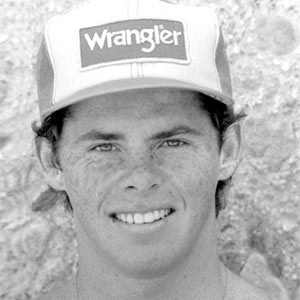 Jeff Ward Jeff Ward | Mission Viejo, CA | 229 |
| 2 |  Broc Glover Broc Glover | El Cajon, CA | 227 |
| 3 |  Ron Lechien Ron Lechien | El Cajon, CA | 223 |
| 4 | 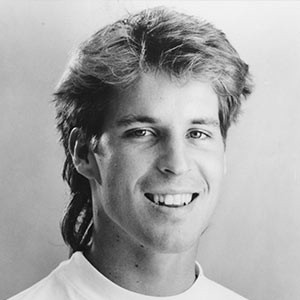 Rick Johnson Rick Johnson | El Cajon, CA | 211 |
| 5 | 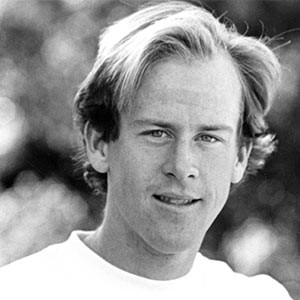 Johnny O'Mara Johnny O'Mara | Van Nuys, CA | 207 |
| 6 | Bridgeview, IL | 163 | |
| 7 |  David Bailey David Bailey | Sugar Tree, VA | 159 |
| Position | Rider | Hometown | Points |
|---|---|---|---|
| 1 |  Jeff Ward Jeff Ward | Mission Viejo, CA | 446 |
| 2 |  Johnny O'Mara Johnny O'Mara | Van Nuys, CA | 428 |
| 3 |  Rick Johnson Rick Johnson | El Cajon, CA | 381 |
| 4 | 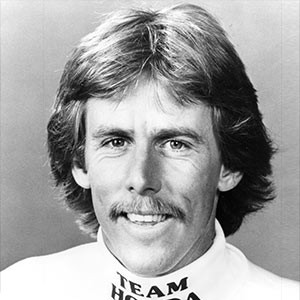 Bob Hannah Bob Hannah | Whittier, CA | 359 |
| 5 | Calimesa, CA | 253 |

I actually rode Wardy’s works bike when I did some of the initial negotiation stuff with Kawasaki for 1986. We went out and rode one of the works 250s. It was good, but I don’t think it was as good as my Hondas!

And don’t forget, Yamaha went to production race bikes in 1984. The rule changed when you had to be on a production-based bike for 1986. Yamaha didn’t have to go to production bikes for two more years, but Yamaha was clearly trying to save money. I think a lot of it was economics.
Pretty regularly we would get boxes of stuff, and man, there would be all of these packages in bubble wrap with different pipes and carburetors and different linkages and forks. It was Christmas all the time!David Bailey

My Hondas [1981-’86] were the best bikes I rode during my career. At the time, my competition probably wouldn’t concede to it—Wardy was the Kawasaki guy, RJ was the Yamaha guy, Broc was a Yamaha guy—but look at it like, RJ comes to Honda with me and goes on to win more championships on the Honda team. I’ve heard other guys say, “Man, I should have considered riding the Honda.” But Honda had the best guys back then. They had the best bikes. Just being blunt about it: Honda had David Bailey, they had me, they had Bob Hannah, they had Ron Lechien, and they had [Danny] “Magoo” Chandler. If they were going to add another person, they were going to have to get rid of one of us.

The Honda conversations motivated me. I didn’t feel like there was going to be another negotiation after the initial one we had, and I was okay with it. Kawasaki had a totally different vibe. It was more family-oriented. It wasn’t so cutthroat or corporate. I felt appreciated. I didn’t feel that way with Honda. That meeting I had with them wasn’t so much about who I was, but more about what they could do for me.

I was all right with riding the 125 in 1985. Actually, at the end of the year in ’84 we went to the Suzuka circuit in Japan, and I think I rode O’Mara’s 125. I raced Wardy and we battled. I had a lot of fun on the bike, and I kind of knew what was going to go on in 1985. People were moving out of the 125 class, and other guys were going here or there. I mean, I knew the top three guys I raced on the 125s my first year [O’Mara, Ward, and Mark Barnett], we’re all going to be gone. Knowing the ’85 Honda works 125 was going to be such a great bike, Honda wanted me down there on that bike, and they asked me to do it. I was like, “No problem!”

We had a group of guys that were just an unbelievable team. I still think that, to this day, that there was no team to ever match that mid-1980s Honda team. We had six or seven factory guys. Look at how much money was being spent. Today, you only get two bikes on the team. And we were all champions too. Honda was spending a lot of money. There may not have even been a budget back then. I got to practice and everyone’s on works bikes. I know the guys today have pretty special machinery, but our stuff was hand-built, and the technology was still going into the bikes.
I was there to win. I assumed that everybody was willing to put in the same effort, but they weren’t. And it showed.Broc Glover

For 1985, our bikes had Simons anti-cavitation system front forks. That was a full-production fork and a full-production triple clamp, and then we had an Ohlins shock, and that was it. We also had stock hubs. I think the most works thing Yamaha gave us that year was a works disc front brake—everything else was absolute production. Both Broc and I struggled, but the good thing about it was that Broc and I had production bikes to practice on. We rode the bikes really well. I rode the 250 well, and Broc rode the 500 well, and that thing was the biggest pile of shit ever. However, Broc was meticulous with his testing with John Rosenthal. The bikes worked well and we rode them well. That’s the greatest thing about moto: if you’re strong and if you can run 100 percent the entire race, the chances are more likely that you’re going to win. That’s the attitude I went with. I went full wide open and so did Broc, and we had success against those guys.

It was at Mount Morris where I finally bunkered down and said to [Yamaha mechanic] John Rosenthal, “Hey, until we fix this part of our bike, we’re going to struggle. Let’s just do one thing only: let’s work on the bottom of the bike.” The bike would bottom out like crazy. It would beat the snot out of me. I said to John, “Let’s just fix that first and foremost before anything else.” Believe it or not, we spent an entire day riding through one dip. Eventually, finally, we figured out the way to fix it was by adding a ton of low-speed dampening, just like Kawasaki. It was all low-speed stuff. We were able to back off some of that high-speed stuff that would knock your teeth out when you were accelerating fast on choppy bumps. By slowing the wheel down with the low-speed stuff, we were really able to control the rear end better, and it tracked a lot better. It all kind of turned my season around in the 500 class. The bike handled to where I could be sort of competitive with David. If that wouldn’t have happened, there was no way I would have won that championship.
| Position | Rider | Hometown | Points |
|---|---|---|---|
| 1 |  Broc Glover Broc Glover | El Cajon, CA | 379 |
| 2 | Tacoma, WA | 316 | |
| 3 |  David Bailey David Bailey | Sugar Tree, VA | 314 |
| 4 | Plymouth, MA | 244 | |
| 5 | Fairburn, GA | 228 |

Pretty regularly we would get boxes of stuff, and man, there would be all of these packages in bubble wrap with different pipes and carburetors and different linkages and forks. Just parts. I’d ask, “What’s all that?” And someone would say, “Oh, that’s just some new stuff.” You just got used to it. It was Christmas all the time! It was exciting to see all of that. Thinking back on the budget, it must have been unlimited.
I raced the 500cc USGP and got to race the works 500 at Carlsbad, and holy crap, that thing was just insane. It was so fast. Just the gnarliest machine I ever rode.Ron Lechien

Rick and I used the equipment we had to kind of motivate us. We tried our best to try and motivate ourselves like that. And you have to understand that at two different times in my career I had Honda try to sign me, and all I had to do was put my signature on the contract and I would have been on a Honda. But I thought being loyal was something that really mattered. People still kind of recognize the fact that I was loyal to Yamaha for so long [1977-’88]. I look back at it, and it wasn’t the best thing that I could have done for my career by any means. I think the part that bothers me the most, to this day, is just that people thought I had this chip on my shoulder, like, “Oh, Broc was kind of hard to please and hard to work with in some ways.” No, I wasn’t. I was there to win. I assumed that everybody was willing to put in the same effort, but they weren’t. And it showed. It’s not just me sitting there going, “Oh, Yamaha didn’t try hard enough.” No. There was a damn good reason that Hannah, Johnson, and [Jeff] Stanton all left. Rick Johnson won just one championship with all his years at Yamaha [1981-’85], and he went to Honda and became basically unbeatable.

Going into ’85, Broc was extra motivated. He really prepared. Bikes aside, the matchup that Broc and I had in ’84 and ’85 was compelling. Machinery also played a role in it, and we were definitely on lopsided machinery. In ’85, Broc really went to work. The bike was still air-cooled, and it still didn’t seem as a cool as my bike, but I think it was actually better.

One thing I remember was Broc racing the air-cooled 490 against David Bailey in the 500 class. Broc could not have had it in his brain that his bike was equal. That was the only bike you could possibly be on and not be able to convince yourself that your bike was better than that Bailey 500. That wasn’t going to happen.

Our 490 engine would lose a ton of horsepower, because you’re racing against water-cooled 500s and you’re making a lot of horsepower through high compression. Compression makes heat, and I never realized how frickin’ bad it was until the ’88 500cc U.S. Grand Prix at Hollister [California] with that 490 motor in a 250 chassis. I qualified up front and was leading a moto, and I would pull this big hill in fourth gear the first two or three laps. Then after three laps I would have to go fourth gear and then downshift partway up the hill to third. By the time the 20-minute mark came up I was going from fourth to third, and then at the top I was having to downshift to second gear. How much horsepower does it take to be able to go up a hill in fourth gear at full speed and on the pipe and then to gear down to where you’re in second gear on an open bike? I was racing against Eric Geboers and Dave Thorpe and them on works Hondas [which were still allowed in the FIM Motocross World Championship]. That was the shit I was racing against. It wasn’t even close. We weren’t even close to being competitive, motorcycle-wise.

The ’85 was a good bike, but I think we had some power issues that we weren’t getting along with. Maybe it worked for Bailey, but not for me. I remember one time I had my bike too pipey, and I took a hammer and started smashing the head pipe at the Texas Supercross, just to tame it down where I wanted it and to keep it where I could hook it up and control it. I remember the people at Honda thinking, What the hell is he doing? I was a pipe builder. I knew how to tune the pipe!

Before the 1985 season, Honda asked me, “Hey, what can we do to make your bike better?” I paused and said, “Um, let me get back to you on that.” In ’85 they had a whole different bike with a small radiator on the left and tucked the pipe in more, and they fixed everything in terms of comfort, but somehow the motor just didn’t have the same surge that the ’84 bike had. It didn’t have the same sound either. The ’84 bike had an oval silencer, and the ’85 bike had a round one. It was the difference between F1 back in the day when it was crazy and screaming loud to where, well, it is now, you know? It’s still amazing, but it doesn’t sound like it did. It didn’t sound fast.

Of all three of the Honda works bikes I rode that year, the 125 was the best overall bike I ever rode, just because it was so fun to ride and turned so well. Then the 250 supercross bike was just insane. That bike was the most radical bike I ever rode. Then I raced the 500cc USGP and got to race the works 500 at Carlsbad, and holy crap, that thing was just insane. It was so fast. Just the gnarliest machine I ever rode. I mean, it was just a beast, but it handled just insanely well and had killer brakes.
| Position | Rider | Hometown | Points |
|---|---|---|---|
| 1 |  Ron Lechien Ron Lechien | El Cajon, CA | 417 |
| 2 | Granada Hills, CA | 378 | |
| 3 | Kerman, CA | 362 | |
| 4 | Sherman Oaks, CA | 288 | |
| 5 | San Jose, CA | 271 |

Nineteen eighty-five was kind of a tough year for me. I had won the two years before with the 125 championship in 1983 and with the supercross title in 1984. While I was #1, the 1985 year is when I hurt my knee at a small little Golden State Series race. After I did tear my ACL there, I had to alter my style a little bit. I did not get it repaired. Back then, if you had knee surgery, you were out all year. From that—and I wasn’t in denial—but I just had that mindset that I could still do it. I actually still did relatively good. I was still winning races, and I was on the podium.
Halfway through the year we were all kicking ass, but it took a while. Works bikes were really neat, but they were also real finicky, and it took a while to get them dialed.David Bailey

I was at the peak of my career in ’85. I had the best equipment and I was in the best shape. My riding was better than anybody else’s. I could get out front and put in five or six hard laps and then just manage the race. I was telling my buddy about it the other day. We were golfing and I told him I’d get out front and put down three or four heaters and then just watch the guys to see if anybody could make a run at me, and nobody could. Same thing with supercross that year. I was head and shoulders above everybody in supercross that year. I kept trying to beat them so hard that I kept crashing. If I was a little smarter…. I mean, all the points I threw in the trashcan that year, and it came down to three points at the end of the series. Looking back, shoot, if I would have just managed a few of the supercross races a little better…. That championship was mine to lose for sure. I just had a lot of crashes that year because I was just trying to kill them. I wanted to demoralize them, you know? Everything just came together that year with my riding and my confidence. I knew I was the baddest dude there.

I really thought I was going to win the two titles in 1985. I felt really strong. In 1984 I learned a lot about racing with Johnny [O’Mara] with the pressure. It just seemed like in ’84 I put the pieces together and I felt stronger and the bike felt stronger. In 1985 I was in a way better place physically. I was healthy and had a real good mental approach to it all. But I didn’t dominate supercross at all. I don’t even consider myself a great supercross rider, period. My whole career, I never felt like I was the best supercross rider. I felt like I was the best outdoor rider—I could get that into my brain. In supercross, I just never wrapped myself around it. I only won one supercross race that year I won the championship. The results didn’t really show how consistent I was because I did win the championship with just one race win. Nobody went out and strung off ten wins that year. I think eight guys won main events that year.

I wasn’t surprised Jeff was that good in ’85. I always felt that our bikes had a little bit of an advantage over Wardy’s machinery, but they were working hard, too, no doubt. I know what my mindset was then as a champion, and we all thought that we were better than everybody. Nobody conceded anything. Nobody thinks like that. If you won four or five races in the supercross series, that was a lot. Nobody dominated in our days. It wasn’t like McGrath or Carmichael winning so many races in a season. Dude, that didn’t exist in our day. The depth of the field was just closer, just like it is today. Who has the most corner speed? In our day it was Mark Barnett. Same with RC and Villopoto in their day. We all figured that stuff out. It was all still breaking new ground for us.

You know, in retrospect, there was a healthy pressure I felt every day at Honda. Every day of every season, I felt a healthy pressure. It didn’t have to be said—I could just sense it. We were there to win, and we were expected to win. I was sensitive to it all and used that as leverage to get the best out of myself. It made me better. The people at Honda that were working on the bikes, and then to have Dave Arnold, who had worked with Marty Smith, and then Roger De Coster came aboard, and then to have an unlimited budget, Honda couldn’t have put together a much better team. I don’t even know if that would have been possible. Everyone and everything there was to extract the best results in function, looks, and sound. I mean, I timed it perfect to be a factory rider. I was there for the very best that they had to offer. You didn’t even have to be looking at the track and you could tell when a Honda went by.
We definitely knew it was going to be the last year of works bikes. The theory back then was to even it all up, but even now, all these years later, it still ain’t even, you know?Ron Lechien

In 1985 I had the sophomore jinx. I think once you win a title—at least I know I did—you feel a little bit entitled. I didn’t work as hard. I felt like, “Well, you’re all going to respect me now.” Then I realized that they didn’t give a shit about that and they’d take you out anyway. I struggled with the bikes too. I had a massive problem with the front forks sticking. I was defeated. I had a couple decent races in ’85, but Wardy was on fire in the 250 class and I couldn’t touch him. Nonetheless, I was definitely giving it a go. The one race that I’m probably the proudest of was the Vegas race, because it was 107 degrees. In the race, Wardy passed me, and when he did, he kind of stuffed me. A lap and a half later they gave the “15 minutes to go” signal and I caught him, and I knocked him off the track and I just kept going. We went back and forth, and I about died. Afterwards, I lost all this weight and started seeing stars. That kind of race didn’t matter what you were on, you were in total misery the whole time. There was no shade in sight. It was tough racing against those guys, but that’s the beauty of motocross. The individual makes a difference in moto.

I didn’t prepare for the ’85 season the same way. I came into the season a little bit belligerent. I was sort of like, “How do I behave?” It all happened so fast. I could come off being a little bit smug. I was just unsure of myself, and I was trying to have a balance in life because I had met Gina [Bailey] in ’84 and I wanted to enjoy my life. But with the racing, I came in way underprepared. Going into 1985, I had sort of gotten comfortable with the idea that, well, I’m the guy. I can pretty much post the fastest lap I want, and I have a bike that will back me up on that. Halfway through the year we were all kicking ass, but it took a while. Works bikes were really neat, but they were also real finicky, and it took a while to get them dialed.

In 1985 I lost my championship, but I was still one of the best guys in the world and one of the best guys on the Honda team. Eighty-five was the last year of the works bike, and Honda was a powerhouse team. We were sad to see the works bikes go. Nineteen eighty-six came about and we still had RJ on the team. Even though I still had some knee problems, I was still pretty healthy. Honda was 1-2-3 in almost every race that year. Maybe David and Ricky had more wins than me, but we were the three best guys in the world. Everything just lined up.

Winning the 125 title was the biggest thing that ever happened to me. To win a title was a goal I set for myself when I was younger. I grew up watching Broc Glover and Marty Smith and Bob Hannah racing 125s, and that was a goal that I set for myself, and that was to be a 125cc National Champion. When I did conquer that and achieve that, it meant a lot to me.

In 1985, and even after, I was never happy. I have to admit, I won my championships. I won the Motocross des Nations. I had GP wins. I had a great career, there is no doubt about it, but I was never satisfied. And the best guys that I know—it was with RC his whole career—it was the same way. You feel like everyone is catching up to you. You start thinking, What can I do to have that edge over everybody? You just lived by the knife every day. I know my mentality then was that I went and trained harder. I was like, “I’m going to ride more hours this week than anybody.” I just had that mindset that I had to do more than anybody. For me, that mental part of it enabled me to be as good as I was for as long as I was.

Unfortunately, the production rule hit me really bad. I was quitting, so I didn’t really care! Then Suzuki got that news and they wanted somebody to test their production bikes, so they hired me to do that, which was a real pain in the ass, frankly. I shouldn’t have agreed to do it. They offered me an agreement for three years, and I signed on to do it. Their bike was horrid at the time, and it took years to get them to work. Nothing happens overnight. The production rule was a real bad deal for Suzuki because they said, “If everyone is just going to run production bikes, we’re just going to run production bikes right now.” The production rule made it really easy for the Japanese. Suzuki said, “Okay, we’ll run our bikes stock.” I then said, “Oh, yeah, that’ll work really well. Do you think Honda is really going to do that?” So Honda, they bent the rules any way to fit them. They could put works Showas on and change shit. And Honda made a good bike. Suzuki didn’t! The Suzuki race bikes went to shit after the production rule went into play. The Suzuki production bikes were junk. Honda, shit, they took advantage of the rules and kicked ass still. Their Honda was fine in 1986. It may not have been as good as an ’83 or ’84 works bike, but it was a damn good bike. But call it production if you want!

We knew the production rule was coming. We definitely knew it was going to be the last year of works bikes. The theory back then was to even it all up, but even now, all these years later, it still ain’t even, you know?

The production rule threw another curve at us because Kawasaki did not have the best production bike. Honda probably did. If they would have said in ’86 that I couldn’t win on any other bike, I might have believed it. I mean, when I raced the 125 Nationals [1979-’84], I was the only Kawasaki on the line. Nobody else rode one. Our production bike was not good enough to race against the other production bikes. It just didn’t progress. Maybe Honda just realized it was all going that way and realized they wanted to put more effort into the production bikes to be closer to the factory bikes. Kawasaki didn’t do that. Once we got to the production rule, things changed a little bit. It wasn’t bad. I still think we were really good, but we kind of went backwards a little bit.

My ’86 production-based Honda was pretty close to my 1985 factory bike. I think that with our technology that we had in the works Honda bike in general, we were still ahead of the game. When we first went to the production rule in 1986, we were already anticipating that we were ahead of the game. Our bikes were still the best, absolutely.

In 1986, Honda was prepping me for success, not failure. It was great to be a part of such a dominant team. Honda gave me a sense of comfort. I’ll never forget when I went up to Hondaland and I had my production Honda that I had been riding and I look over and see Johnny and David’s brand-new bikes there. Then they pull my brand-new bike out and I’m like, “I get a brand-new bike?” They said yeah and I said, “Holy shit!” Then I looked around my bike and there were three pipes and two or three cylinders and there were a couple shocks and another set of triple clamps. I said, “Holy cow, this is awesome!” Honda had a way of making you feel special as a rider. Here’s the thing: When you’re in, you’re in. When you’re out, you’re out. When it’s over, it’s over. Yamaha is more of a family type of thing. They keep you around and stuff like that. Honda was like, “We’re going to pay you to win, and when you’re done winning, we don’t really need you anymore.” That’s hard to take sometimes, but also, it’s the truth, you know what I mean?

When Rick went over to Honda, he said to me, “Broc, I swear to you, at Honda and HRC there are more people designing 250 exhaust pipes than frickin’ everyone who worked in Yamaha’s OW department.” Rick talked about how Honda didn’t like their riders using Mitch Payton’s pipe. They were more like, “Man, we’ve got to be able to build a better pipe than some guy in Anaheim.” They kind of had that attitude. Rick was dumbfounded. It was like a whole other world to him.

When the whole thing went to the production rule in ’86, I think Honda just had the best bike, period. The Honda made Ricky, who was a great rider already, even better. When you think you could win on the Yamaha and then get on the Honda and then realize how much better a bike it was, your confidence just goes through the roof. Honda is the kind of company, some people need to push them, because they are a company that wants to win badly. You really have the pressure to deliver, and I think that worked well with RJ because he was the kind of personality that thrived on that. I wasn’t surprised how well Rick was doing on that bike.

It was really a privilege to be on the pointy edge of the works-bike stuff, with Honda just throwing everything they had at it. Honda was like, “Hey, you know what else would be cool?” Honda would do that. They didn’t think, Hey, wouldn’t it be cool if… Honda thought, Hey, that’s cool, let’s do that! When the works-bike era ended, Honda just completely went, “Well, we can’t do all that, so forget about it.”

I was really good friends with the president of Honda and with Roger [De Coster] and [Dave] Arnold. Things were really good there. I should have signed again and said, “I’ll take less money, but I want support until I’m sick of it.” If I had to do it over again, I would have said, “Honda, you don’t have to pay anything, just give me full support with a truck, bikes, mechanics, and bonuses.” That’s the deal I should have cut, because I could have still won quite a few races. I could have won a lot of races on a good bike, because I could still ride, obviously. I even won races clear out in 1989 on those piece-of-shit Suzukis. I needed to be on a good bike. If I would have been on a damn Honda, I could have won a lot of races.

The last time I rode that 125 was at the 1985 Motocross des Nations in Germany. That was really cool. That was a really big accomplishment for me. I mean, that was a bucket-list deal. To go over and represent Team USA and to be on that team was awesome. After we won, just to be standing in this huge tent with all these people with beer mugs yelling and screaming was really, really cool. It was all so killer.

At the end of the year, we did the All-Japan GP in Sugo, then we went to go do some testing of the new production bikes. After we were done, I knew we had a little time while we were loading up, so I jumped back on that ’85 250 and rode and rode until Dave Arnold came down and said, “Okay, we gotta go.” I actually ignored him the first time I came around because I wanted to ride it a little bit longer. I knew that was going to be it, that this was the last factory bike I would ever ride. I knew I’d never see that bike again. And I loved that bike. It was really hard to get off it and say goodbye. I hated the production rule. Hated it. When works bikes were gone, a part of me was gone too.
1985 Wins By Rider
| Position | Race | Class | Date | Bike |
|---|---|---|---|---|
| 1 | Motocross Spring Creek Motocross | 125MX | August 11, 1985 | Honda |
| 1 | Motocross Broome-Tioga Sports Center | 125MX | July 27, 1985 | Honda |
| 1 | Motocross RedBud Track 'n Trail | 125MX | July 7, 1985 | Honda |
| 1 | Motocross Lakewood Sports Cycle Center | 125MX | June 16, 1985 | Honda |
| 1 | Motocross Six Flags | 125MX | June 2, 1985 | Honda |
| 1 | Motocross Las Vegas Motocross Park | 125MX | May 19, 1985 | Honda |
| 1 | Supercross Orlando | 250SX | April 27, 1985 | Honda |
| 1 | Motocross Hangtown Motocross Classic | 125MX | March 31, 1985 | Honda |
| 1 | Supercross Seattle 2 | 250SX | February 9, 1985 | Honda |
| 1 | Supercross Seattle 1 | 250SX | February 8, 1985 | Honda |
| Position | Race | Class | Date | Bike |
|---|---|---|---|---|
| 1 | Motocross RedBud Track 'n Trail | 250MX | July 7, 1985 | Yamaha |
| 1 | Motocross Las Vegas Motocross Park | 250MX | May 19, 1985 | Yamaha |
| 1 | Supercross Irving | 250SX | May 4, 1985 | Yamaha |
| Position | Race | Class | Date | Bike |
|---|---|---|---|---|
| 1 | Motocross Washougal Motocross | 250MX | August 25, 1985 | Honda |
| 1 | Supercross Pasadena | 250SX | August 17, 1985 | Honda |
| 1 | Motocross Broome-Tioga Sports Center | 250MX | July 27, 1985 | Honda |
| 1 | Supercross San Diego | 250SX | January 26, 1985 | Honda |
| Position | Race | Class | Date | Bike |
|---|---|---|---|---|
| 1 | Motocross Lakewood Sports Cycle Center | 250MX | June 16, 1985 | Kawasaki |
| 1 | Motocross Six Flags | 250MX | June 2, 1985 | Kawasaki |
| 1 | Motocross High Point Raceway | 250MX | May 26, 1985 | Kawasaki |
| 1 | Supercross Houston | 250SX | April 20, 1985 | Kawasaki |
| 1 | Motocross Hangtown Motocross Classic | 250MX | March 31, 1985 | Kawasaki |
| 1 | Motocross Gatorback Cycle Park | 250MX | March 3, 1985 | Kawasaki |
| Position | Race | Class | Date | Bike |
|---|---|---|---|---|
| 1 | Motocross Spring Creek Motocross | 500MX | August 11, 1985 | Honda |
| 1 | Motocross Six Flags | 500MX | June 2, 1985 | Honda |
| 1 | Motocross High Point Raceway | 500MX | May 26, 1985 | Honda |
| 1 | Motocross Las Vegas Motocross Park | 500MX | May 19, 1985 | Honda |
| 1 | Supercross Los Angeles | 250SX | May 11, 1985 | Honda |
| Position | Race | Class | Date | Bike |
|---|---|---|---|---|
| 1 | Motocross Broome-Tioga Sports Center | 500MX | July 27, 1985 | Yamaha |
| 1 | Motocross RedBud Track 'n Trail | 500MX | July 7, 1985 | Yamaha |
| 1 | Motocross Lakewood Sports Cycle Center | 500MX | June 16, 1985 | Yamaha |
| 1 | Motocross Hangtown Motocross Classic | 500MX | March 31, 1985 | Yamaha |
| 1 | Motocross Gatorback Cycle Park | 500MX | March 3, 1985 | Yamaha |
| 1 | Supercross Anaheim | 250SX | February 2, 1985 | Yamaha |
| Position | Race | Class | Date | Bike |
|---|---|---|---|---|
| 1 | Motocross Spring Creek Motocross | 250MX | August 11, 1985 | Honda |
| 1 | Supercross Daytona | 250SX | March 9, 1985 | Honda |
